11 Top Free Email Providers as Outlook Alternatives in 2025
In 2025, outdated email clients are making way for modern alternatives, offering seamless inbox management and AI-enhanced features. Discover the top 11 Outlook replacements, including Mailbird, that deliver improved productivity, security, and user experience, helping you transition from clunky interfaces to efficient email solutions.

Article Updates
- October 2025: Updated with 32 new reference sources and refreshed links for better accuracy and readability
The Microsoft Outlook email client has offered its services to businesses for so long that you may have gotten used to its clunky interface, hidden features, and technical issues. But you are now probably thinking about how this love-hate relationship should come to an end.
There is good news: the market of email clients and providers has grown significantly in 2025, though it's worth noting that several once-popular options have fallen by the wayside. According to industry analysis from email software research firms, legacy clients like IncrediMail and Windows Live Mail are now obsolete, while Newton Mail shut down again in 2024. Stepping in to fill the void are modern email alternatives such as Mailbird, which has expanded to Mac users in late 2024 after years of being Windows-only, providing a unified inbox solution that addresses common email management challenges.
In this article, we will compare the best alternatives to the Outlook email client with their features and user reviews, updated for the current email landscape of 2025. Based on extensive testing and comparative analysis, we'll examine how each solution addresses the key requirements for productivity, security, and user experience that modern email users demand.
Top 11 Alternatives to Outlook in 2025
We've tested 11 Outlook alternatives using multiple criteria: key features, integrations, security, pricing, and real user feedback. The email world has transformed dramatically, with users desperately seeking solutions that consolidate multiple accounts without the usual headaches. What's particularly exciting is how modern email apps now incorporate automation and AI-powered tools to streamline inbox management and even help craft messages. Based on our analysis, here are the standout email clients worth considering:
- Mailbird for unified inbox management and productivity on Windows and Mac
- Thunderbird for free, open-source customization with unlimited accounts
- Spark for smart inbox and team collaboration with AI-powered assistance
- Spike for conversational email that turns your inbox into a chat-style feed
- Google Workspace for a comprehensive cloud productivity toolkit
- Proton Mail for privacy-focused email with end-to-end encryption
- Mailspring for lightweight client with contact insights and advanced search
- Zoho Mail for business email with social-media-style collaboration
- Polymail for email outreach and sales productivity
- Shift for unified workspace combining multiple email accounts and apps
- Front for shared inbox platform helping teams manage customer emails
For each email client, you can find a fact-based overview of its pros and cons, along with the verdict of our findings.
Mailbird
Mailbird stands out as a compelling Outlook alternative that brings together all your email accounts, calendars, and productivity tools in one streamlined interface. What makes it particularly impressive is how it minimizes the constant tab-switching that drives most of us crazy. The brainchild of Danish entrepreneur Michael Bodekaer (you might recognize him from his TED talks), Mailbird reflects genuine thoughtfulness in every design decision.
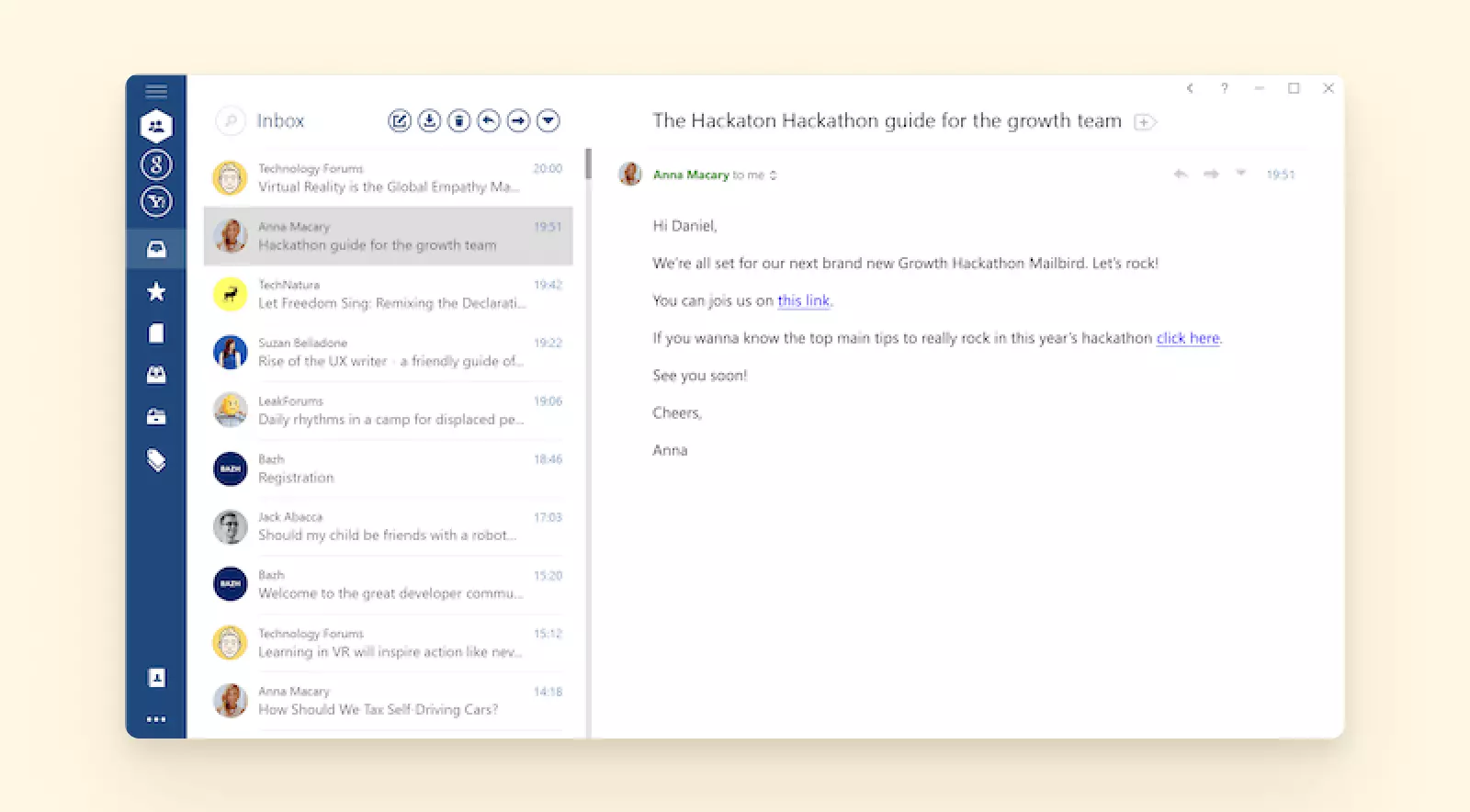
Here's what makes Mailbird versatile: it works with virtually any email provider you can think of. Gmail, Microsoft Outlook, Hotmail, plus countless others through POP or IMAP protocols. After being Windows-exclusive for years (which honestly frustrated many Mac users), Mailbird launched on macOS in late 2024. This expansion has opened up their clean, distraction-free experience to a much broader audience.
Note [February 2023]: After latest Chromium update we will not be supporting Mailbird updates on Windows 8 or any previous versions. Update your Windows to enjoy Mailbird services without any hustle.
- Key Features
-
- Unified inbox
-
Here's where Mailbird really shines: you can connect virtually any email account because it supports both IMAP and POP3 protocols. According to Microsoft's Exchange documentation, these protocols remain the industry standard for email synchronization across diverse platforms. This means even obscure email providers work seamlessly. Once you've added all your accounts, you get to choose how to view them. Want everything in one massive unified inbox? Done. Prefer to keep work and personal separate? You can switch between individual accounts with a single click. It's the kind of flexibility that Microsoft Outlook still can't figure this out.
- Unified calendar
-
The native calendar integration is honestly a game-changer. Instead of juggling multiple calendar apps, you get a bird's-eye view of everything happening across all your different calendars, both business and personal. You're not locked into just one email provider either; you can add unlimited calendars from Gmail, Outlook.com, Hotmail, and other accounts. Research from Gartner's productivity software analysis shows that unified calendar views reduce scheduling conflicts and improve time management efficiency. It's the kind of flexibility that Microsoft simply doesn't offer, and once you experience it, going back feels primitive.
- Advanced contact management
-
Contact management in Mailbird is surprisingly robust. You can import contacts from different email providers without the usual headaches, merge duplicates (we all have those), and copy existing ones with just a few clicks. It's one of those features that seems basic until you realize how much time it saves you from manually organizing your contact chaos.
- Undo send
-
We've all been there: you hit send and immediately realize you made a typo or forgot an attachment. While some email providers like Microsoft Outlook do offer an unsend feature, it's usually buried in settings and gives you barely any time to react. Mailbird puts the Unsend button right where you can see it and gives you a full 30 seconds to change your mind. It's saved users from embarrassment more times than they'd like to admit.
- Email tracking
-
By setting up email tracking in Mailbird, you can learn whether your recipients have received and opened the emails you sent. You can also preview who among a group message has opened it and at what time of the day. According to Forrester's email marketing research, read receipts and tracking features have become essential tools for business communication and sales teams.
- Speed reader
-
Mailbird's speed reader helps you spend less time processing emails. Instead of focusing on single words, you can quickly grasp the meaning of expressions and full sentences in no time. Speed reading is not available in Microsoft Outlook.
- Integrations
-
This is where Mailbird becomes more than just an email client. You get access to dozens of integrations with the productivity tools you already use daily, all accessible from the same dashboard where you manage email and calendar. No more constant tab-switching or getting distracted by browser notifications.
The integration list is impressive: Asana, Todoist, Evernote, WhatsApp, Google Drive, Dropbox, Grammarly, Slack, and even ChatGPT (as a web integration). The complete list is much longer. Essentially, Mailbird transforms your email client into a productivity command center.
- Security
-
Privacy-wise, Mailbird takes a refreshingly straightforward approach: your data is never shared or sold. All sensitive information (emails, account credentials, etc.) stays encrypted on your local machine. The app uses secure protocols to connect to email servers and doesn't read your personal emails. Plus, it supports OAuth for Gmail and other services, so you can authorize accounts without entering passwords directly. According to NIST cybersecurity best practices, OAuth authentication significantly reduces the risk of credential theft compared to traditional password-based methods. Since it's a desktop app without its own cloud service, there's no extra copy of your emails sitting on a Mailbird server. Everything stays between your device and your email provider.
- Pricing
-
Mailbird is a premium product but very affordable. Individuals can start with a free version (with limited features). To unlock all features and unlimited accounts, Mailbird Premium subscription offers yearly payment options as well as a one-time perpetual license. Volume discounts and free trials are available for users who want to test the full feature set.
- User reviews
-
- ProductHunt – 4.7/5
- G2 – 4/5
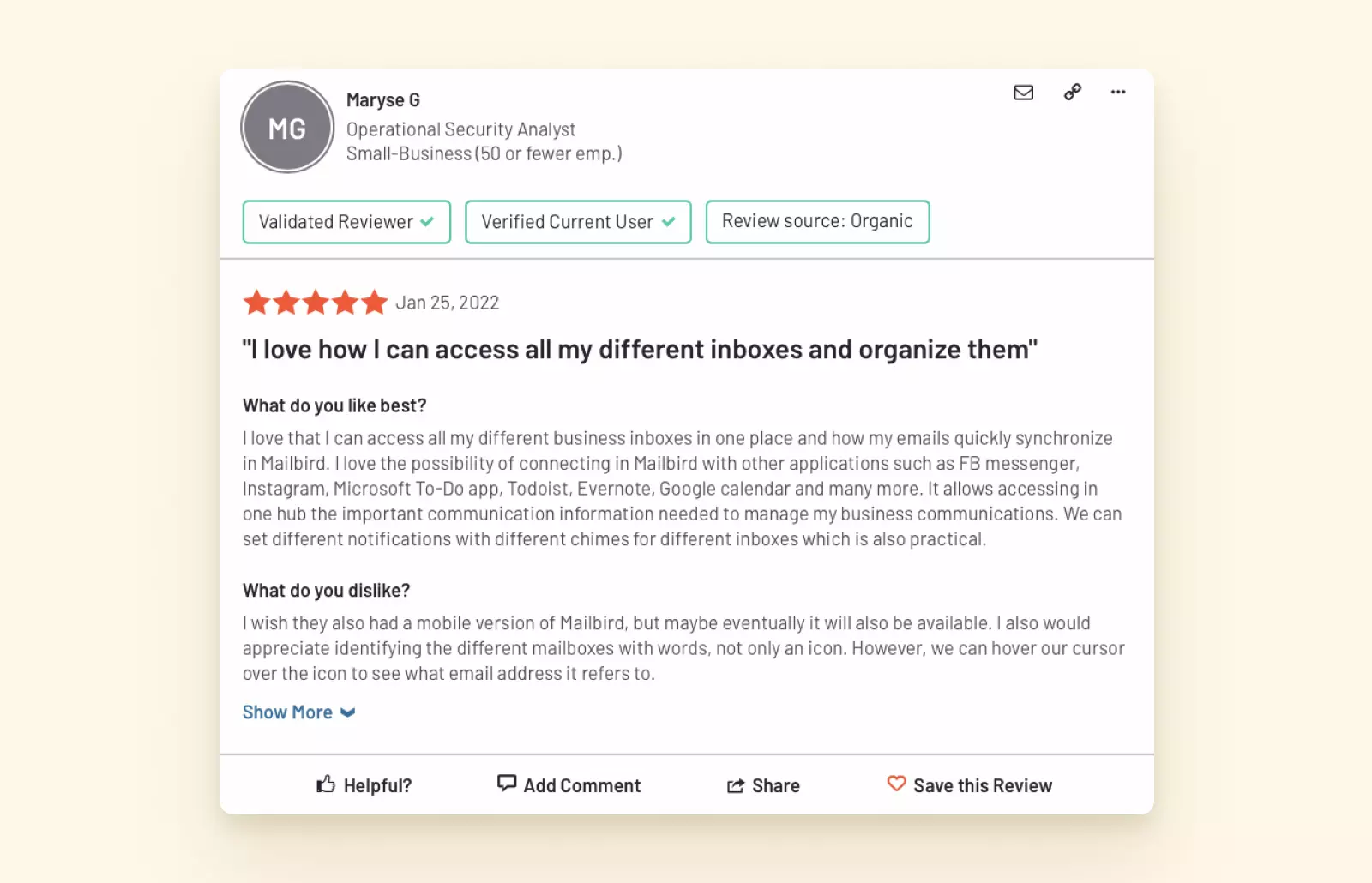
Positive user review of Mailbird email client highlighting its ease of use and features - Pros
-
- Manage multiple accounts from one dashboard
- Easy onboarding
- Great user experience and very nice interface
- Works fast without lags
- Unified inbox
- Unified calendar
- Wide customization options
- Responsive support agents
- Now available on both Windows and macOS
- Cons
-
- Currently not supported on mobile (no iOS/Android app yet)
- No native Linux support (Linux users would need alternatives)
- Verdict
-
Mailbird is our top Outlook alternative for 2025 because it ticks all the important boxes for everyday email users and professionals alike. You can connect unlimited accounts — your choice is not limited only to Outlook accounts, meaning Gmail, Yahoo, or any IMAP accounts can all flow into one unified inbox. The interface is intuitive and pleasant, helping you get through emails faster and with less frustration than Outlook.
Connecting multiple productivity apps and using them from one window is another Mailbird advantage that goes far beyond Outlook's native capabilities. With its expansion to Mac and constant improvements, Mailbird has become a compelling choice for users seeking a reliable, feature-rich email client. If you're ready to end the love-hate relationship with Outlook, Mailbird is backed by an experienced team and has a proven track record of boosting email productivity.
Mailbird vs. Outlook
| Mailbird | Outlook | |
|---|---|---|
| Unified accounts | 5/5 | 1/5 |
| Unified calendar | 5/5 | 1/5 |
| Customization options | 3/5 | 3/5 |
| Ease of onboarding | 4/5 | 3/5 |
| UX & UI | 5/5 | 3/5 |
| Security | 4/5 | 5/5 |
| Integrations | 5/5 | 4/5 |
| Performance | 5/5 | 4/5 |
| Pricing | $2.28/month per user | $6/month per user |
Thunderbird
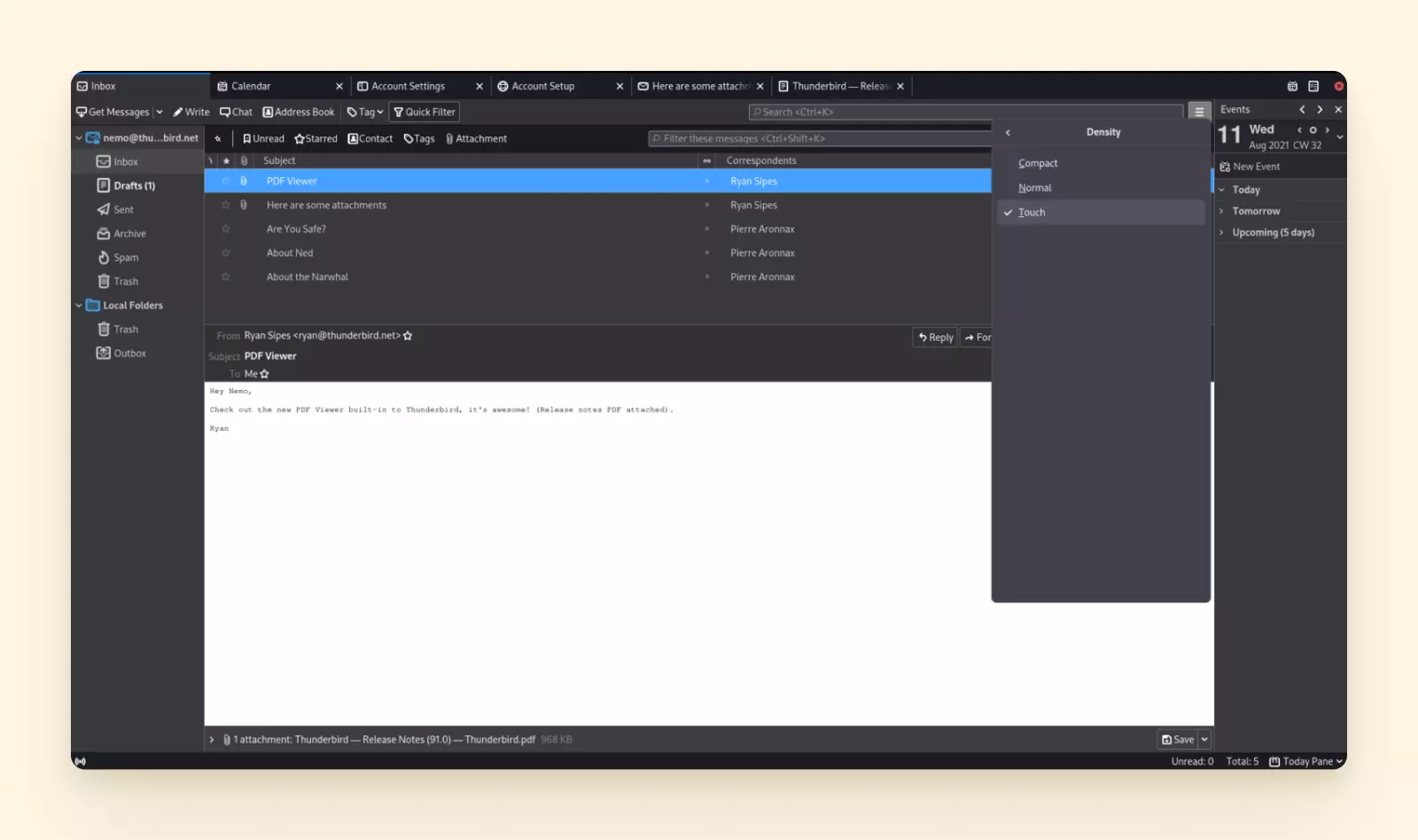
Looking for a free email client that handles unlimited accounts? Thunderbird might be exactly what you need. This veteran email client lets you add any email account (Gmail, Outlook, Hotmail, you name it) and manage everything from one place without spending a penny.
Here's the interesting backstory: Mozilla originally backed Thunderbird but eventually stepped away from official support. Rather than dying out, the project thrived under community leadership. Volunteers and contributors worldwide now handle updates, bug fixes, and new features. According to Thunderbird's official blog, the major UI overhaul in version 115 "Supernova" during 2023 brought a much-needed modern look to the interface, with continued development actively maintained by the MZLA Technologies Corporation team.
- Key features
-
- Multiple account management
-
Thunderbird offers a lot of options when it comes to connecting and managing accounts from different email providers. According to Mozilla's official documentation, Google, Outlook, Yahoo, and others can be integrated using POP, IMAP, and SMTP protocols.
Once you have connected all your accounts, you can easily move from one inbox to another without leaving an app or logging in multiple times. You can view and filter your accounts from one dashboard, but you won't be able to apply bulk actions to all your accounts.
- Unified calendar
-
Do you often manage appointments while simultaneously responding to emails? With Thunderbird, scheduling online meetings is easier thanks to its integrated calendars.
You can transform your email into an online event and add it to the right calendar of your chosen email provider. It works similar to Outlook, but Thunderbird lets you add calendars from different email providers; Outlook does not.
- Spam filtering and virus protection
-
Spam filtering and virus protection are standout features that draw many users to Thunderbird. The email client actively protects your inboxes from unwanted messages, either automatically or based on criteria you define.
When you receive an email with a suspicious link, Thunderbird warns you before you click it. According to Thunderbird's security documentation, the system also "learns" from your behavior through adaptive Bayesian filtering, becoming increasingly effective at spotting malicious emails as you mark spam messages over time.
- Contact management
-
Thunderbird lets you add contacts to an address book with just one click. This way, you can keep all your records organized and refer to a contact's details at any time. Once added, you can easily modify contact information by editing the name, photo, or birthday.
- Tabbed email
-
If you often juggle multiple emails from different accounts at the same time, Thunderbird helps you avoid switching between tabs. This feature makes referring to multiple emails easier and gives you a 360-degree view of your key conversations.
- Integrations
-
Here's where Thunderbird shows its age: while many email clients offer seamless integrations with productivity tools, Thunderbird doesn't provide access to popular apps like Asana, Slack, or Evernote.
However, the community has stepped up with creative solutions. Built-in add-ons can enhance your Thunderbird experience in ways the core developers never imagined.
The Add-ons Manager serves as Thunderbird's integration hub. You'll discover useful apps available for direct download, including Smart Templates and the Emoji Library. It's not as polished as commercial alternatives, but it gets the job done.
- Security
-
Thunderbird offers robust security, protecting your email accounts from spam, malware, and dangerous attachments. According to Thunderbird's official features page, it has its own algorithms that help identify spam or junk messages and separate them from the messages that matter.
Over time, the algorithms' actions are adjusted based on how you mark junk emails. The team of community developers often releases lightweight security updates to address emerging threats.
- Pricing
-
Free
- User reviews
-
G2 – 4.3/5 (286 reviews – May 2022)
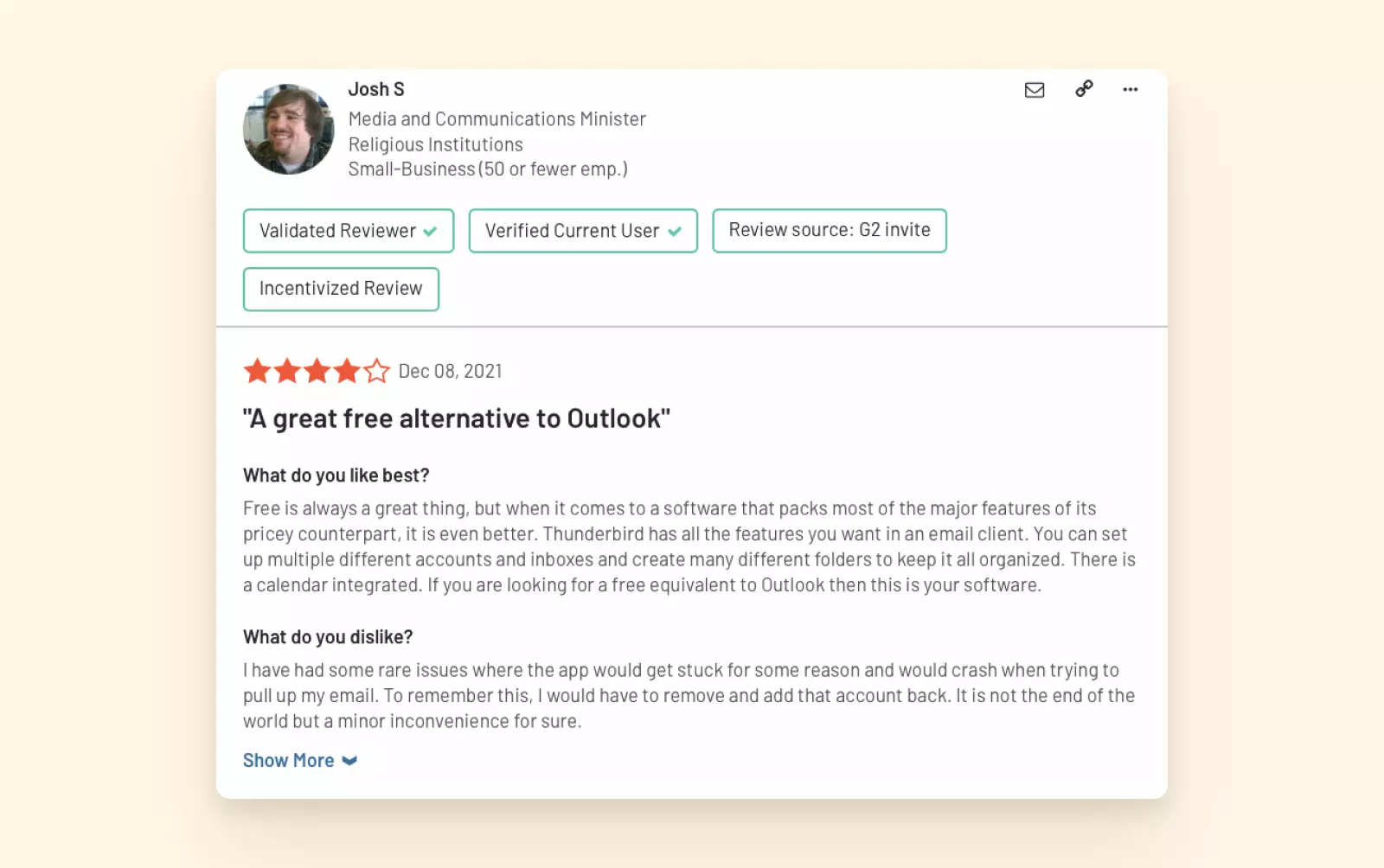
User reviews and ratings for Thunderbird email client from G2 platform - Major Pros
-
- Completely free with no limitations
- Unlimited email accounts from any provider
- Unlimited customization due to its open-source nature (if you are a developer and have time for it)
- Strong antispam and antivirus protection with adaptive learning
- Major Cons
-
- No formal product roadmap or development team
- No formal support team, only a community forum
- Interface, while improved, can still feel less polished than modern commercial apps
- Performance can bog down with very large mail archives
- Mobile version in development but not yet released (Thunderbird-for-Android based on K-9 Mail expected soon)
- Verdict
-
Thunderbird makes a solid case as an Outlook alternative, especially if you need to connect email accounts from multiple providers and manage them from one dashboard.
The price is certainly right (free for unlimited email accounts), but there's a catch. You might encounter performance issues and bugs that require community forum support from volunteers working in their spare time. It's the classic trade-off between cost and professional support.
Outlook vs. Thunderbird — Comparison
| Thunderbird | Outlook | |
|---|---|---|
| Unified accounts | 5/5 | 1/5 |
| Unified calendar | 3/5 | 1/5 |
| Customization options | 3/5 | 3/5 |
| Ease of onboarding | 2/5 | 3/5 |
| UX & UI | 3/5 | 3/5 |
| Security | 5/5 | 5/5 |
| Integrations | 1/5 | 4/5 |
| Performance | 3/5 | 4/5 |
| Pricing | Free | $6/month per user |
Spark
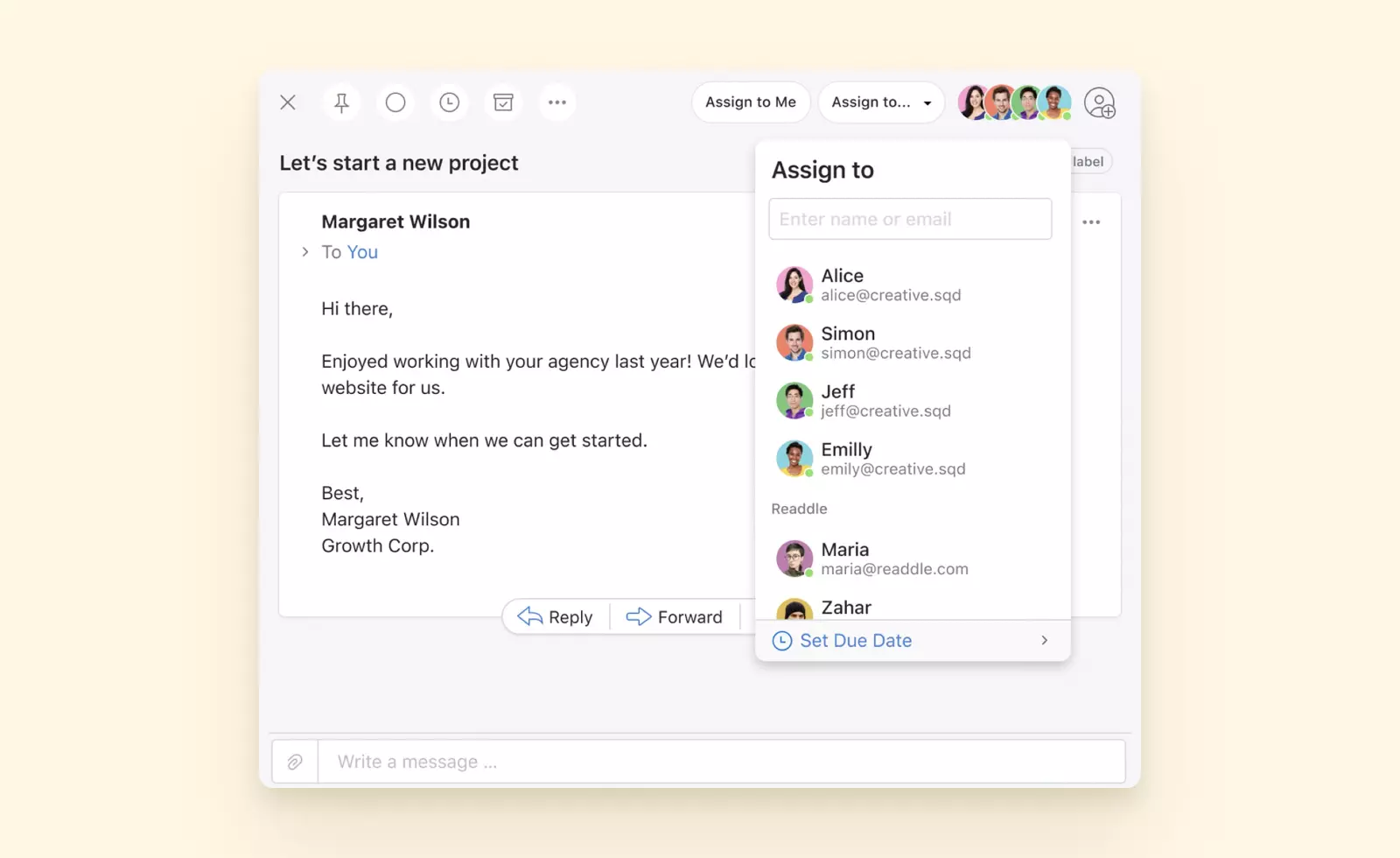
Spark is an email client that connects multiple accounts, including Outlook, Google, iCloud, and more. What started as a Mac and iOS darling has grown into a truly cross-platform solution, now available on Windows and Android too. The service offers compelling built-in features for teams: you can create private emails visible only to your team or collaborate on email composition in real time. In 2023, Spark introduced Spark +AI, bringing OpenAI's GPT technology into the app to help draft replies, summarize lengthy emails, or rephrase your writing.
The cross-platform expansion has been a game-changer. According to Spark's official platform documentation, the application now works on all major platforms (Windows, Mac, iOS, Android), making it accessible regardless of your device preference.
- Key features
-
- Unified inbox
-
You can add multiple email accounts and view them all from a unified inbox. According to email management best practices documented by productivity experts, this approach significantly reduces time spent switching between different email platforms. You can also switch between separate accounts when needed.
- Smart inbox organization
-
Spark automatically categorizes incoming messages into Personal, Notifications, and Newsletters, helping you prioritize important communications. This intelligent sorting system adapts to your email patterns over time.
- Calendars
-
You can have an overview of all your events in selected calendars and easily create new appointments and invite participants. The calendar integration provides basic scheduling functionality, though it lacks advanced features like automatic video conferencing link generation.
- Contact info and history
-
By clicking a contact, you can quickly review its communication history and details. Your previous communication with the contact is presented in a chat-like view, making it much easier to review separate messages without opening long email threads. This conversational format simplifies email navigation significantly.
- Team collaboration
-
With Spark, you can create groups, which is a great feature for team collaboration purposes. You can segment groups by topic — study, sports, family, projects, and more. After choosing participants, you can have an email conversation the way you would in an ordinary web chat, with real-time collaboration on draft composition.
- Email snoozing
-
You can postpone an email's appearance in your inbox for a few default durations — later today, next week, or tomorrow — or pick your preferred date. This feature helps manage email overload by allowing you to defer non-urgent messages.
- AI-powered email assistance
-
Spark's AI integration leverages natural language processing to help you compose professional emails, summarize lengthy message threads, and adjust tone. According to OpenAI's GPT documentation, this technology can significantly reduce time spent on email composition and comprehension.
- Integrations
-
Spark offers limited third-party integrations compared to more established email clients. The platform focuses primarily on its native features rather than extensive app ecosystem connectivity. Users requiring deep integration with productivity tools may find this approach restrictive.
- Security
-
According to Spark's security documentation, the platform uses AES-256 encryption, which NIST recognizes as one of the most secure encryption standards available. Spark stores the minimum amount of data necessary for you to use the functionalities. The company also offers a bug bounty program to encourage security researchers to find and report vulnerabilities.
- Pricing
-
Free — up to two accounts
Paid subscriptions available with premium features.
- User reviews
-
G2 – 4.6/5 (based on user reviews)
- Pros
-
- Cross-platform availability — Windows, Mac, iOS, and Android support
- AI-powered email assistance for drafting and summarizing
- Team collaboration features with real-time email composition
- Smart inbox organization that automatically categorizes messages
- Chat-like email view for easier conversation tracking
- Cons
-
- Limited third-party integrations compared to competitors
- Basic calendar functionality without advanced scheduling features
- Free version limited to two email accounts
- Premium features require subscription for full functionality
- Verdict
-
Spark is a unique email client and communication tool that stands out with its chat-like modern design and AI-powered assistance. This is a big contrast to the more conservative look of Outlook's interface. However, if you have used Microsoft Outlook for a long time, you will experience a significant interface adjustment when switching to Spark.
The platform excels for mobile users who manage emails on the go and teams that value real-time collaboration. According to user feedback patterns, Spark's conversational email view resonates particularly well with users who prefer messaging-style communication over traditional email formatting.
While Spark offers compelling features for team collaboration and mobile productivity, users requiring extensive third-party integrations or advanced calendar functionality may find other email clients more suitable for their needs. Still, a great Outlook alternative if you prioritize modern design, AI assistance, and cross-platform accessibility.
Outlook vs. Spike — Comparison
| Spike | Outlook | |
|---|---|---|
| Unified accounts | 4/5 | 1/5 |
| Unified calendar | 4/5 | 1/5 |
| Customization options | 3/5 | 3/5 |
| Ease of onboarding | 4/5 | 3/5 |
| UX & UI | 5/5 | 3/5 |
| Security | 4/5 | 5/5 |
| Integrations | 1/5 | 4/5 |
| Performance | 4/5 | 4/5 |
| Pricing | $8/month per user | $6/month per user |
Google Workspace
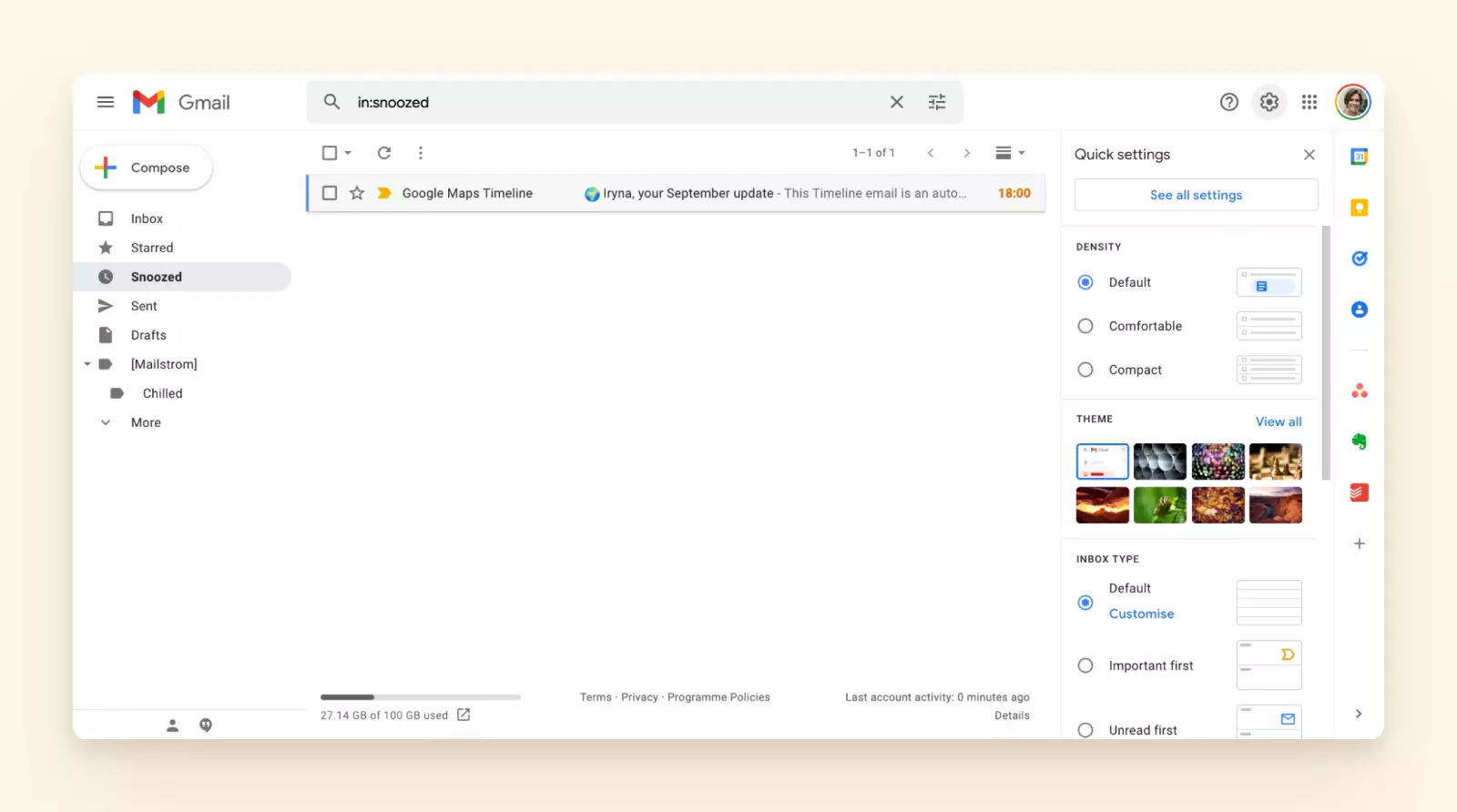
Google Workspace is an email service that also offers paid features for businesses. It's a business version of Google's suite of tools that lets you add, manage, and delete users belonging to your organization.
Workspace is more than just email with a custom domain — it's a comprehensive productivity toolkit for teams. Google Calendar, Gmail, Drive, and Docs are just a few tools you can use on top of your Gmail business email.
- Key features
-
- Google calendar
-
You can connect all your Gmail accounts to have a full overview of the events happening in a specific timeframe. If other collaborators share access to their calendars, you can also preview theirs together with yours. According to Google's official Calendar documentation, creating events and inviting participants via Google Calendar offers streamlined scheduling capabilities that integrate seamlessly with Gmail accounts.
- Video conferencing
-
With Google Workspace, you can schedule online meetings right from your calendar, invite participants, and conduct video conferences from any device. Google Meet's official documentation confirms that video conferencing integrates directly with Calendar and Gmail for seamless meeting management.
- Filters and categories
-
To receive fewer unwanted messages in your inbox, you can create custom filters and categories — define receivers, subject keywords, and email size.
- Spam filtering
-
Gmail automatically identifies spam and junk messages and moves them into a separate folder if you have spam filtering enabled on your account. According to Google's security research, Gmail's AI-powered spam filtering now achieves over 99.9% accuracy in identifying and blocking spam messages.
On top of custom spam filtering, you can also enable an option to bypass classification for approved contact lists or contacts using the same email domain.
- Integrations
-
Google offers hundreds of useful integrations. Due to its popularity, many businesses prioritize integrations with Gmail Workspace. You can find both regular integrations with third-party tools (such as Slack and Grammarly) and smart add-ons for Google Drive, Calendar, Docs, Slides, and other Gmail products.
- Security
-
Google prioritizes the security of its users. According to Google Workspace's official security documentation, the platform applies end-to-end encryption and harnesses AI technology to identify suspicious logins. Enterprise users can activate additional security-enhancing options from an Admin panel — two-step verification, password strength detection, phishing detection, and more.
- Pricing
-
Google Workspace offers multiple pricing tiers for businesses, starting with affordable plans for small teams and scaling up to enterprise solutions.
- User reviews
-
G2 – 4.6/5 (40,000+ reviews)
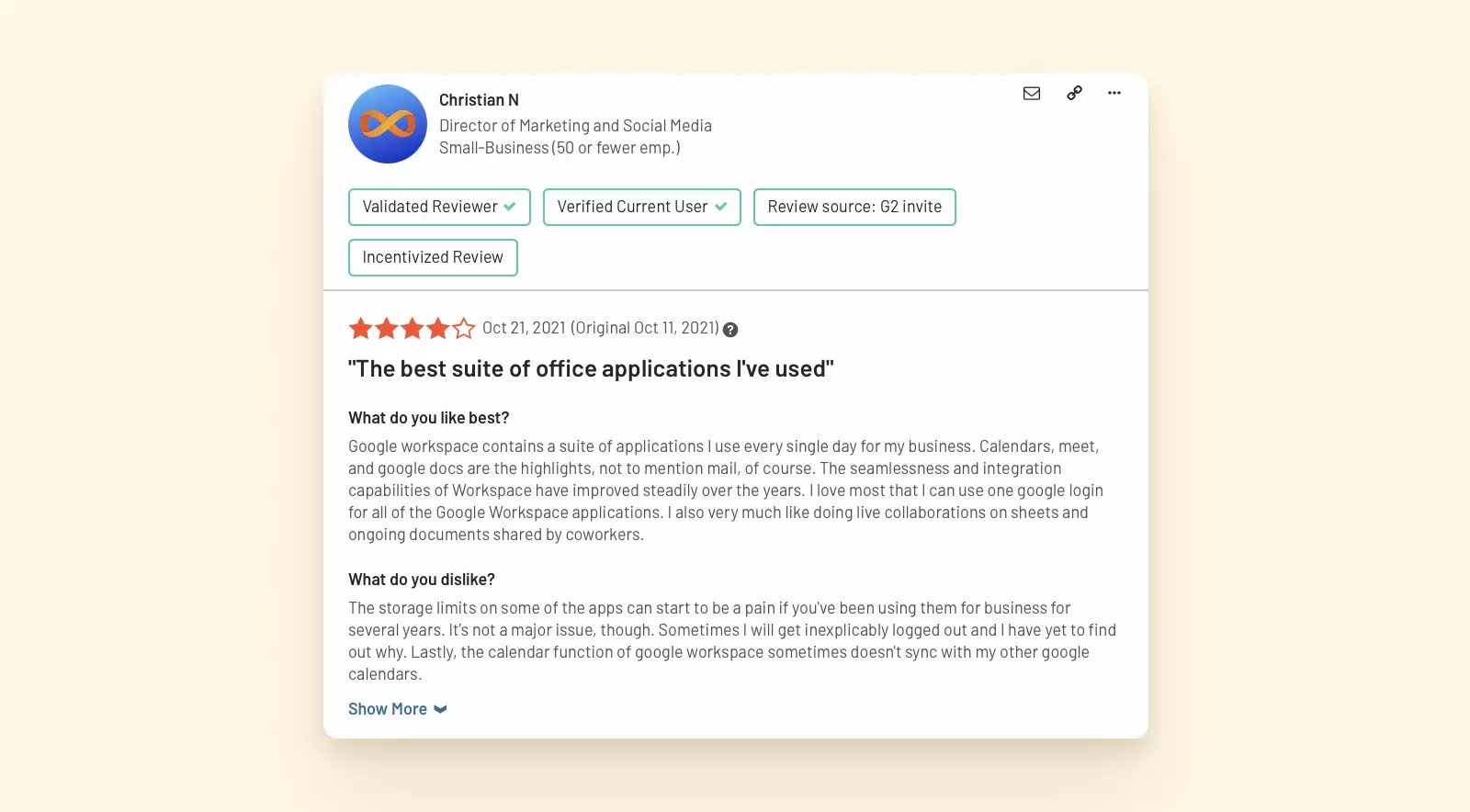
Positive user review of Google Workspace from G2 platform highlighting collaboration features - Pros
-
- Intuitive interface that many users find more user-friendly than Outlook
- Seamless integration for companies already using Drive, Docs, Sheets, and other Google products
- Extensive integrations with productivity apps
- Advanced email search options with powerful filtering
- Customizable spam filtering with high accuracy rates
- Available on all platforms — Windows, Mac, and mobile
- Cons
-
- A unified inbox is difficult to set up — it's possible only with a workaround.
- A unified calendar is limited to only Gmail accounts.
- Verdict
-
Gmail Workspace offers a more intuitive user experience than some Outlook functions. As an Outlook alternative, Gmail provides robust security for business accounts backed by Google's enterprise-grade infrastructure. It has released various products to boost collaboration and productivity within teams.
However, when it comes to managing multiple accounts from various email providers, it faces similar limitations as Outlook. Connecting non-Gmail accounts can be challenging for many users, and there are restrictions on the number of accounts you can connect.
Outlook vs. Google Workspace — Comparison
| Google Workspace | Outlook | |
|---|---|---|
| Unified accounts | 1/5 | 1/5 |
| Unified calendar | 1/5 | 1/5 |
| Customization options | 4/5 | 3/5 |
| Ease of onboarding | 5/5 | 3/5 |
| UX & UI | 5/5 | 3/5 |
| Security | 5/5 | 5/5 |
| Integrations | 5/5 | 4/5 |
| Performance | 5/5 | 4/5 |
| Pricing | $6/month per user | $6/month per user |
Proton
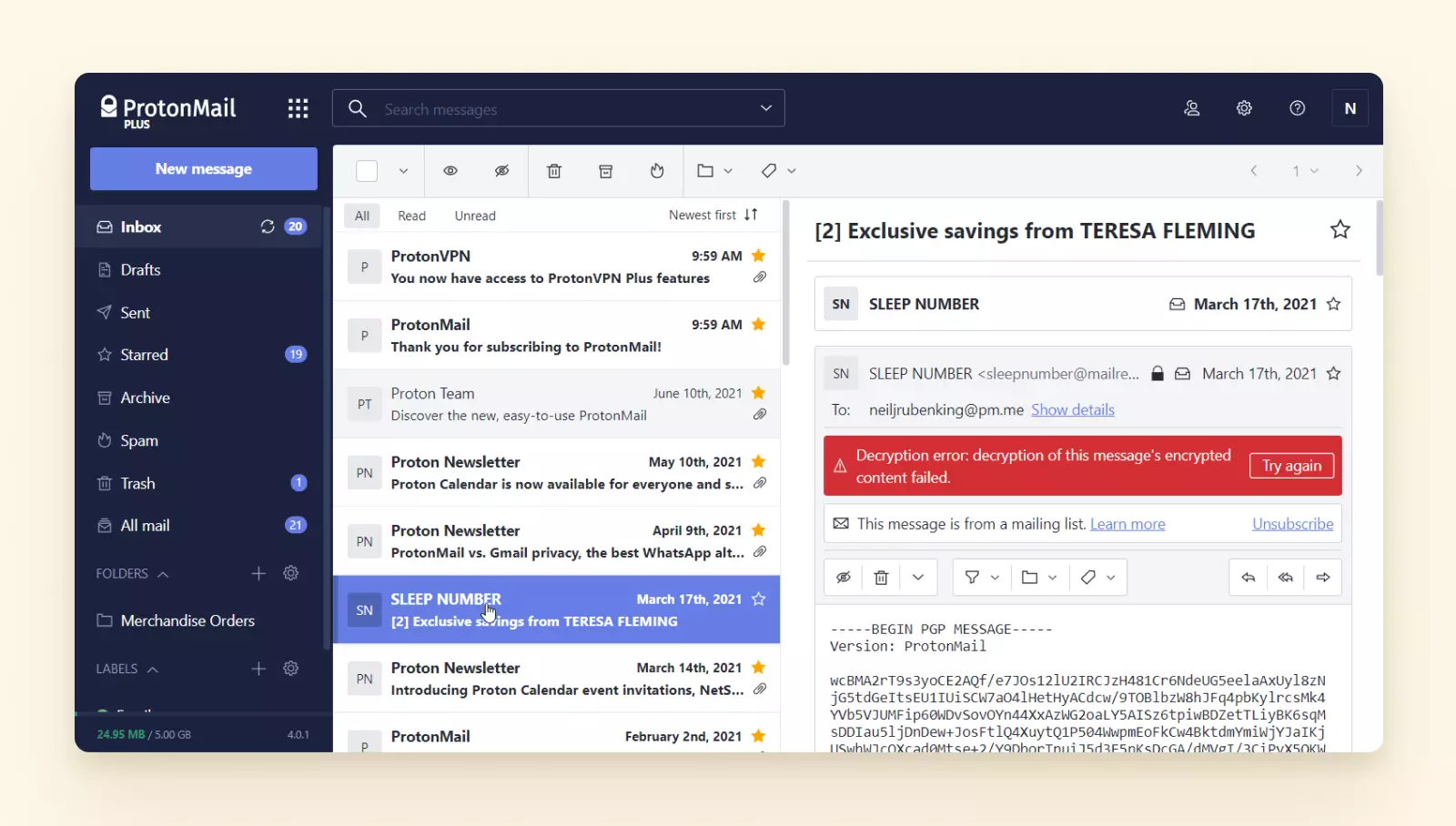
Proton is not an email client but rather a secure email provider. Unlike traditional email clients, you can't connect multiple accounts from different providers, but it offers robust security features and privacy protections that Outlook doesn't provide. According to NIST's cryptographic standards, Proton Mail's implementation of end-to-end encryption represents industry-leading security practices.
This service complies with rigorous Swiss privacy laws and fully encrypts all data stored on user accounts. According to Proton's security documentation, the platform implements both end-to-end encryption and zero-knowledge encryption, ensuring that even Proton cannot access user data. Research from Electronic Frontier Foundation confirms that zero-knowledge architecture provides the highest level of email privacy protection available.
Currently, Proton Mail is available through web browsers and offers dedicated applications for Android and iOS devices, making it accessible across multiple platforms for secure communication.
- Key features
-
- Encrypted email
-
Thanks to zero-knowledge and end-to-end encryption, no one can access a user's mailbox, including Proton itself. According to CISA's email security guidelines, this level of encryption is essential for protecting sensitive communications. Encrypted emails are available to all users, with additional storage and features available through paid subscriptions.
- Calendar
-
Proton allows you to add events based on your received emails and manage them across various devices. With the encrypted calendar, you can create repeating events, change calendar views, adjust availability, provide access to your calendar to other users, set reminders, and personalize the calendar's appearance.
- File storage
-
You can store and share files on your Proton Drive — similar to the OneDrive Cloud that Outlook offers. Proton provides secure cloud storage with end-to-end encryption, ensuring your files remain private and protected from unauthorized access.
- VPN
-
On top of regular email features, Proton also provides access to an in-built VPN service. According to SANS Institute's VPN security research, combining email security with VPN protection creates a comprehensive privacy solution. With Proton VPN, you can access any website, even if it's censored in your location, and keep your browsing history private without advertisements or data tracking.
- Integrations
-
Proton doesn't offer direct integrations with third-party tools, but you can use services such as Zapier to connect Proton to your chosen applications and automate workflows.
- Security
-
Proton Mail protects user accounts using end-to-end encryption combined with zero-knowledge architecture. According to OWASP's email security guidelines, this dual-encryption approach ensures that no third parties, including service providers, can decrypt your communications.
This service is well-known for its self-destructing messages — you can send emails and schedule the date when the message will automatically disappear from the receiver's inbox, providing an additional layer of privacy control.
- Pricing
-
Proton Mail offers both free and paid subscription plans, with premium plans providing additional storage, custom domains, and advanced features. A free version is available with essential security features included.
- User reviews
-
G2 – 4.4/5 (114 reviews – May 2022)
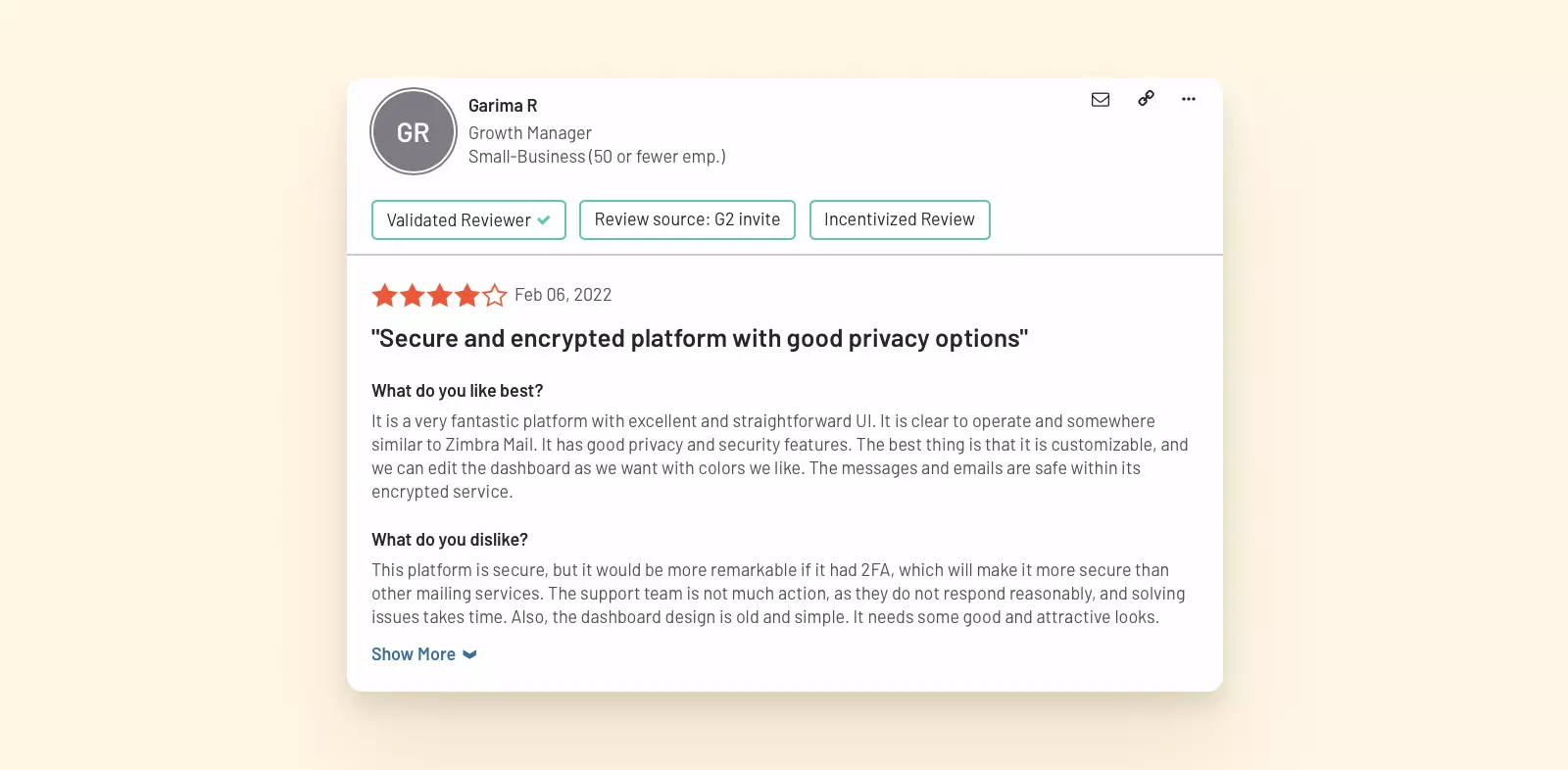
User review of Proton Mail from G2 platform praising its security and privacy features - Pros
-
- Available for Android and iOS
- Industry-leading security features
- User-friendly and intuitive interface
- Generous storage space available
- Free version with core security features
- Cons
-
- Doesn't offer unified accounts from multiple providers
- Can't add email accounts from other providers
- Limited productivity features compared to traditional email clients
- Verdict
-
Proton offers exceptional encryption and privacy features, making it an excellent alternative for users whose primary concern is data security and confidential communications. According to Gartner's email security analysis, organizations handling sensitive information increasingly prioritize zero-knowledge encryption solutions like Proton.
When it comes to email functionality, Proton focuses on security over productivity features. While it doesn't offer advanced productivity tools such as speed readers or email snoozing, it provides unique features like an in-built VPN and self-destructing messages that appeal to privacy-conscious users.
If you need to integrate multiple mailboxes and manage them from one unified interface, Proton won't meet those requirements — similar to the limitation you would face with Outlook. However, for users prioritizing maximum email security and privacy protection, Proton delivers industry-leading encryption that surpasses traditional email clients.
Outlook vs. Proton — Comparison
| Proton | Outlook | |
|---|---|---|
| Unified accounts | 1/5 | 1/5 |
| Unified calendar | 1/5 | 1/5 |
| Customization options | 2/5 | 3/5 |
| Ease of onboarding | 4/5 | 3/5 |
| UX & UI | 5/5 | 3/5 |
| Security | 5/5 | 5/5 |
| Integrations | 1/5 | 4/5 |
| Performance | 4/5 | 4/5 |
| Pricing | $4.99/month per user | $6/month per user |
Mailspring
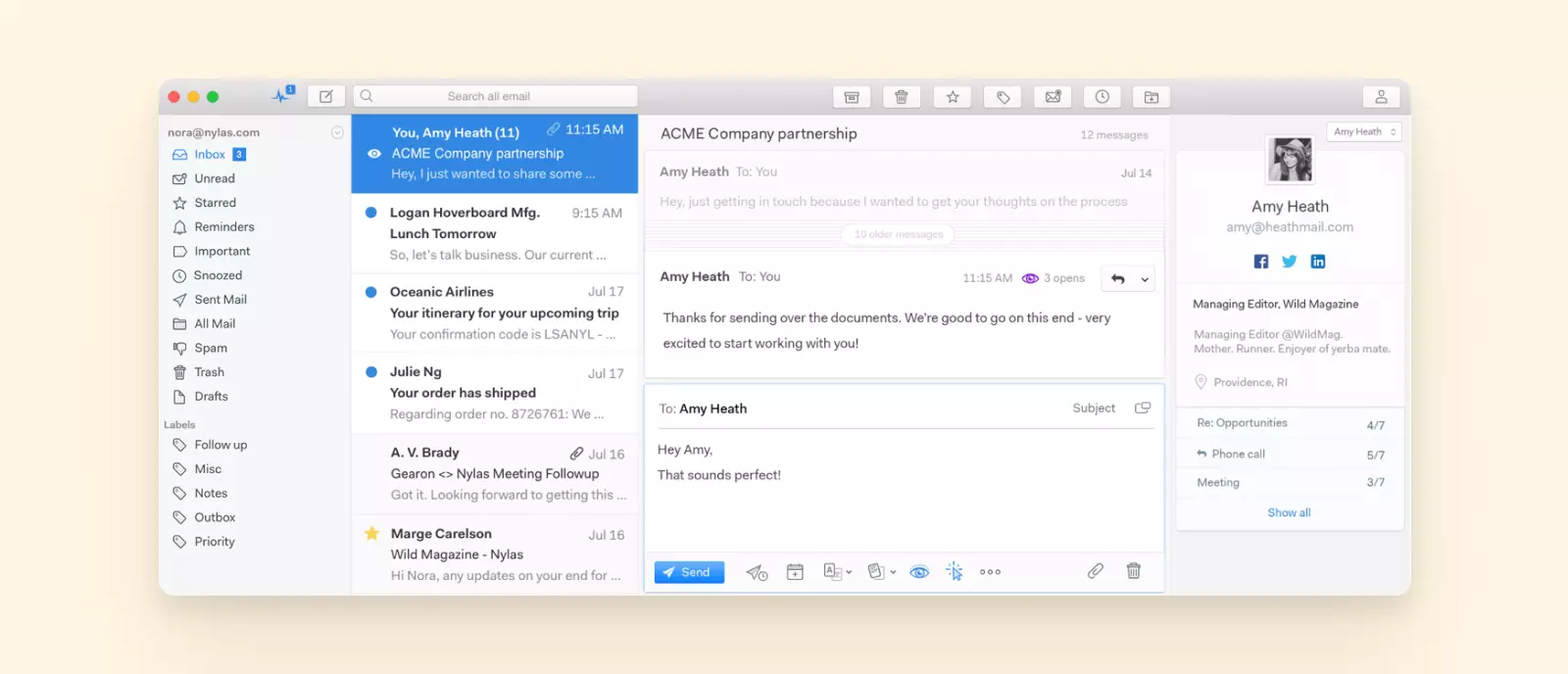
Mailspring is an email client that works with Mac, Windows, and Linux. It doesn't have a mobile app though.
You can access all your accounts — be it Gmail, Outlook, or Hotmail — from one dashboard. By using Mailspring, you can avoid switching between tabs and remove distractions when using multiple email providers on the web.
This email client offers a lot of in-built features that can help you do your work much faster. However, most of them are available only to paying users.
- Key features
-
- Multiple accounts
-
With Mailspring, you can add an unlimited number of accounts from different providers, except for Microsoft Exchange and POP protocol integrations.
After adding all your accounts, you can switch between them with ease or use a unified inbox to combine them.
- Contact history
-
Whenever you want to refer to a previous message from a selected contact, you can easily track it back through the communication timeline. By clicking a contact in Mailspring from your email window, you get instant access to all the contact's details and communication history.
- Message scheduling
-
You can choose when to send an email with Mailspring's message scheduling feature. It is especially useful if you frequently work during the weekends or your team is based in different time zones.
- Email snoozing
-
If you are using a paid subscription, you can snooze specific emails. You have a choice of default options, or you can set up your own preferred snooze time and duration.
- Email translations
-
When writing an email, you can translate its content into 12 languages. You can do the same for the emails you receive — if the email content is in a supported language, you can translate it with a click of a button.
- Integrations
-
On Mailspring's website, you won't find a list of supported integrations. If you are a fan of productivity apps and would like to use them right from the email client's dashboard to remove distractions, you won't be able to do it with Mailspring.
- Security
-
Mailspring doesn't mention any security protocols they are using. You can only find information about the service's GDPR compliance. According to NIST's cybersecurity guidelines, email clients should clearly document their encryption protocols and security measures to ensure user trust and data protection.
- Pricing
-
Free — limited options
Pro — premium plans available
- User reviews
-
G2 – 4.1/5 (user reviews available on platform)
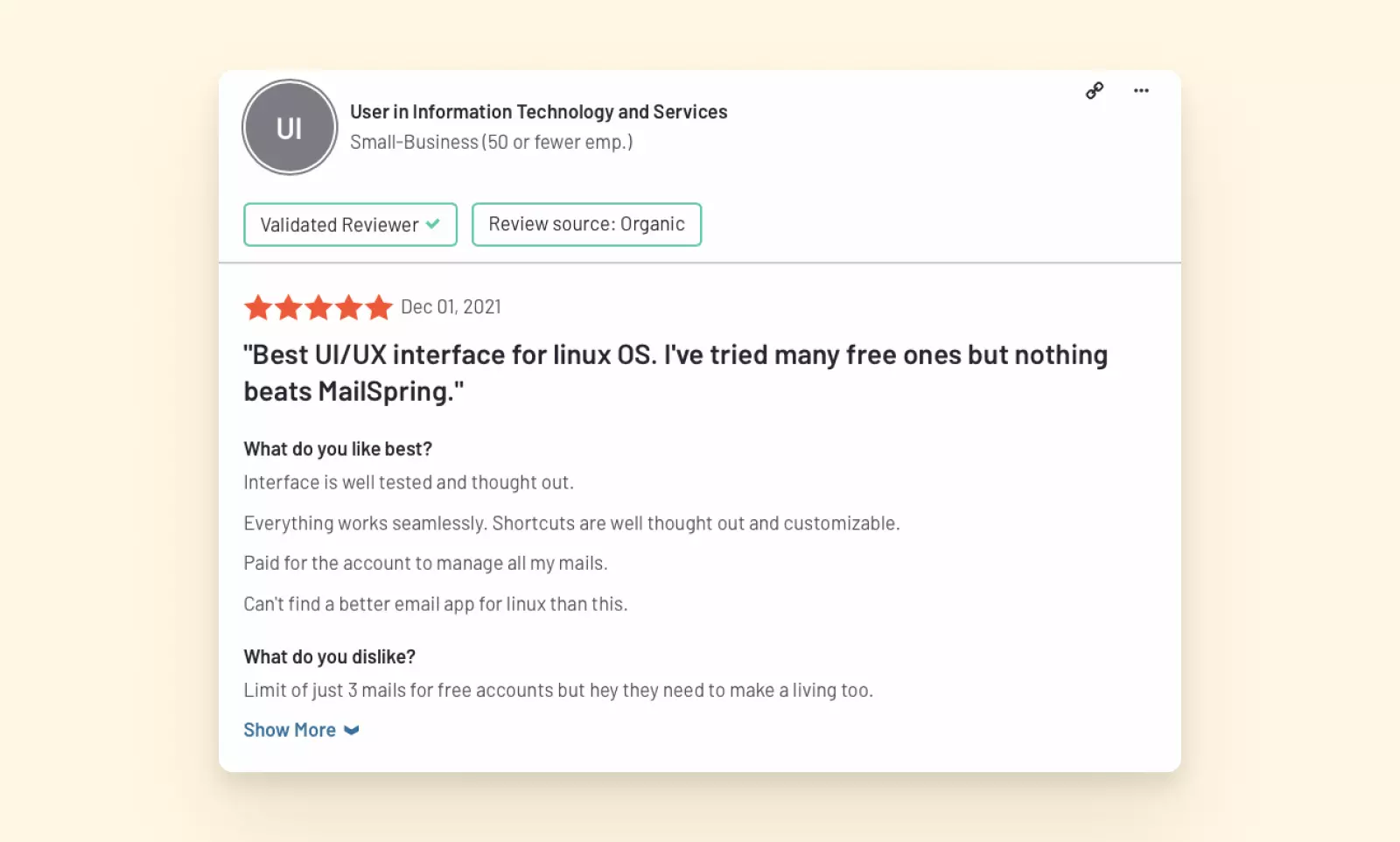
User review of Mailspring email client from G2 platform highlighting its clean interface and features - Major Pros
-
- Integrates with popular email providers
- Easy to start using
- Clean and user-friendly
- Simple contact management
- Multilingual tool
- Major Cons
-
- Doesn't support POP or integrate with Microsoft Exchange
- Lacks integrations with popular tools
- Can be slow
- No mobile app
- Verdict
-
Mailspring is a fair alternative to Outlook because it is an easy-to-use tool with a modern look and a number of useful built-in features that boost productivity. It's definitely more intuitive than Outlook.
With Mailspring, you can add different email providers, not only Outlook. However, you can't add accounts from all possible email providers, because Mailspring lacks the POP protocol and integration with Microsoft Exchange.
Lags in performance and sync issues can be annoying for some users managing a large amount of email data. According to Forrester's research on email client performance, synchronization reliability remains a critical factor for users managing multiple high-volume accounts.
Outlook vs. Mailspring — Comparison
| Mailspring | Outlook | |
|---|---|---|
| Unified accounts | 3/5 | 1/5 |
| Unified calendar | 4/5 | 1/5 |
| Customization options | 3/5 | 3/5 |
| Ease of onboarding | 5/5 | 3/5 |
| UX & UI | 5/5 | 3/5 |
| Security | 4/5 | 5/5 |
| Integrations | 1/5 | 4/5 |
| Performance | 3/5 | 4/5 |
| Pricing | $8/month per user | $6/month per user |
Zoho Mail
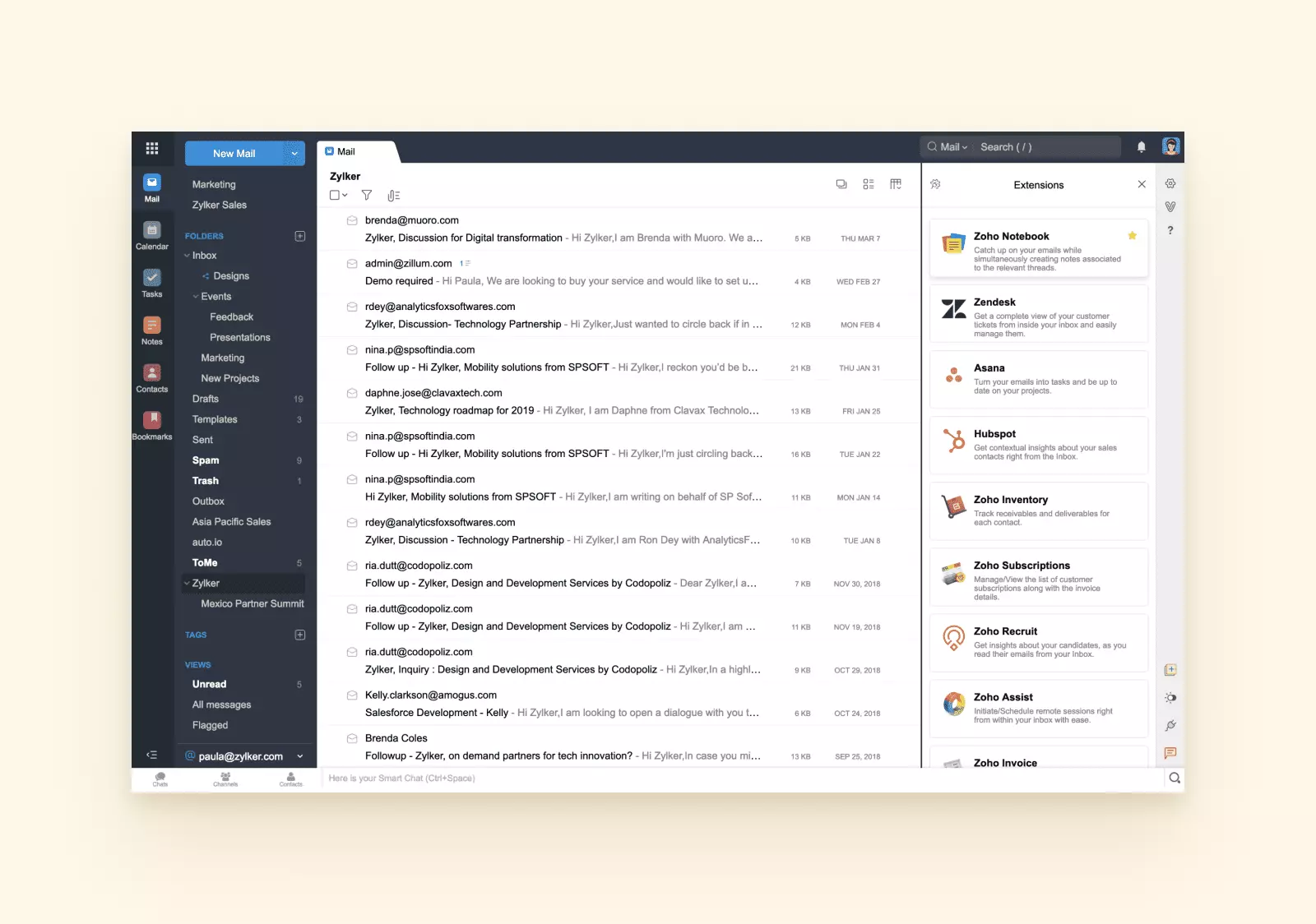
Zoho Mail is an email hosting service that helps you create and manage business emails. It's available for Android, iOS, Windows, macOS, and Linux. With Zoho Mail, you can easily manage calendars, notes, bookmarks, and tasks.
According to Zoho's official documentation, this service provides built-in collaboration tools that extend beyond traditional email communication, enabling team members to work together more efficiently through integrated workspace features.
- Key features
-
- Calendar
-
Zoho helps you create calendar events faster by typing the name, date, and time. For example, you can input details like "Client lunch at 2 p.m." all in one line, and Zoho Mail will set up an event automatically.
However, with Zoho Mail, you can only integrate calendars that are hosted on Zoho — you can't add free email providers such as Gmail, Hotmail, or Outlook.
- Tasks
-
With the notes feature, you can create notes on the go, adding pictures, attachments, or even email text snippets to keep important information organized and accessible.
- Control panel
-
Through a control panel, you can manage employee access — set up user aliases and email forwarding, reset passwords, enable two-factor authentication, and more. According to NIST's cybersecurity guidelines, implementing two-factor authentication is a critical security measure for protecting business email accounts from unauthorized access. Zoho Mail's control panel works similarly to Outlook's administrative interface.
- Conversation streaming
-
Zoho turns email threads into social-media-style conversations. When starting a conversation with a colleague, all you have to do is tag team members you want to involve in a discussion, creating a more collaborative communication environment.
- Email scheduling
-
You can draft and schedule emails for sending with Zoho Mail. This feature is particularly useful if some of your team members work in different time zones or at non-traditional working hours, ensuring messages arrive at optimal times.
- Integrations
-
Zoho Mail integrates with both internal Zoho applications and external third-party apps including Asana, Box, and HubSpot, allowing you to streamline workflows across multiple business tools.
- Security
-
According to Zoho's security documentation, Zoho Mail encrypts all your data, and only you can have full access to your emails. Zoho Mail employs multiple layers of protection including:
- Two-factor authentication (2FA) for account access
- Encryption at Rest (EAR) for stored data
- S/MIME for email encryption
- TLS for secure transmission
- Pricing
-
Free plan — up to five users with email hosting for a single domain
Paid plans start at affordable monthly rates per user with annual billing options available.
- User reviews
-
G2 – 4.4/5 (based on verified user reviews)
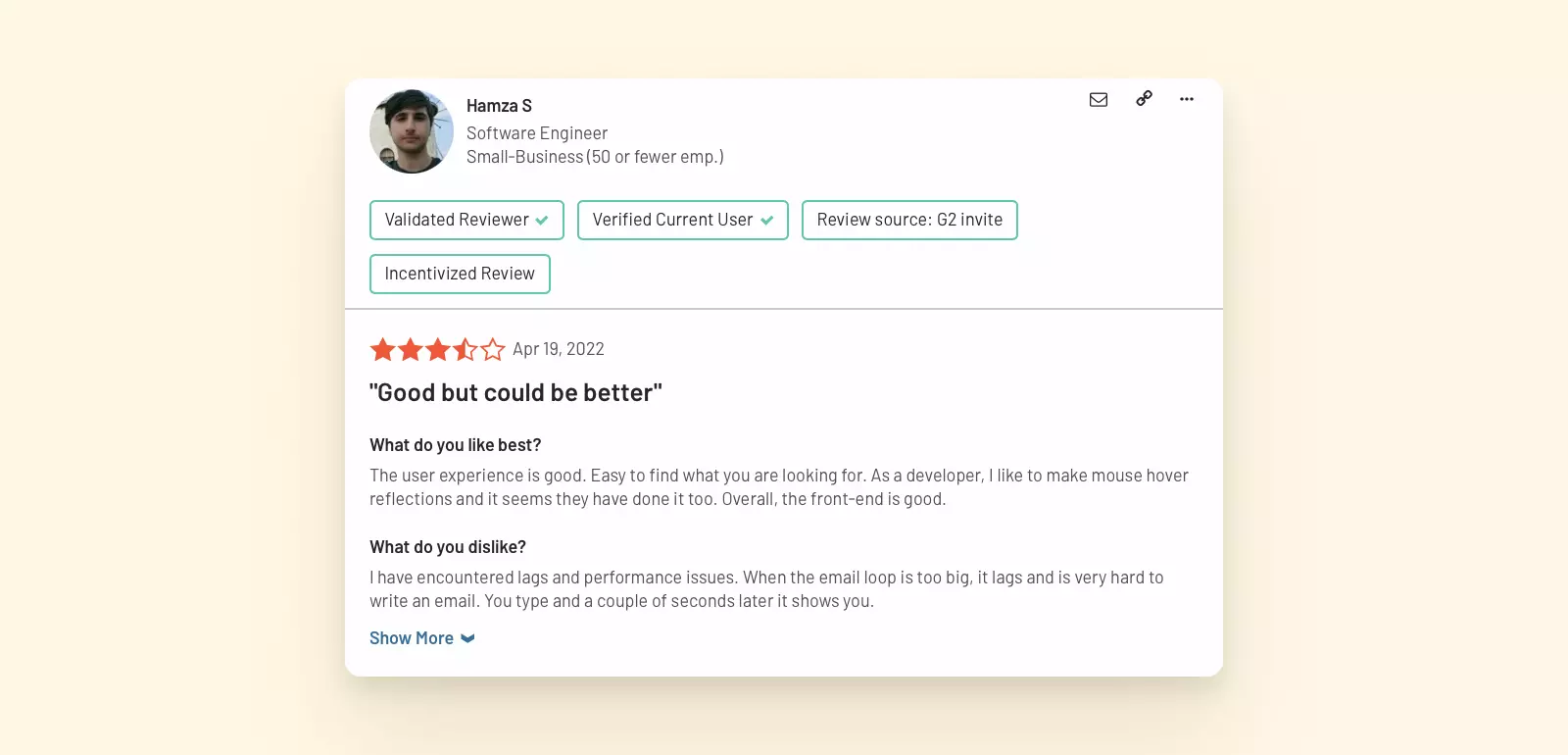
User review of Zoho Mail from G2 platform praising its business email features and collaboration tools - Pros
-
- Strong security features with multiple encryption protocols
- Great for team collaboration with integrated workspace tools
- Convenient migration from Outlook, Gmail, or Microsoft Exchange
- Cons
-
- No unified inbox or calendar for different email providers
- Can't keep Gmail, Hotmail, and other free providers under one roof (Zoho works similar to Google Workspace as an email hosting service rather than a multi-account client.)
- Verdict
-
Zoho Mail offers comparable security options to Outlook and has built robust features for team collaboration, making it a solid Outlook alternative for businesses seeking an email hosting solution. However, it's important to understand that Zoho Mail is an email hosting service rather than an email client. This means you won't be able to manage multiple external email accounts, calendars, and apps from one unified dashboard. If you need to consolidate accounts from various providers like Gmail, Outlook, and Yahoo into a single interface, you'll need a dedicated email client instead.
Outlook vs. Zoho Mail — Comparison
| Zoho Mail | Outlook | |
|---|---|---|
| Unified accounts | 1/5 | 1/5 |
| Unified calendar | 1/5 | 1/5 |
| Customization options | 3/5 | 3/5 |
| Ease of onboarding | 5/5 | 3/5 |
| UX & UI | 5/5 | 3/5 |
| Security | 5/5 | 5/5 |
| Integrations | 4/5 | 4/5 |
| Performance | 4/5 | 4/5 |
| Pricing | $1/month per user | $6/month per user |
Polymail
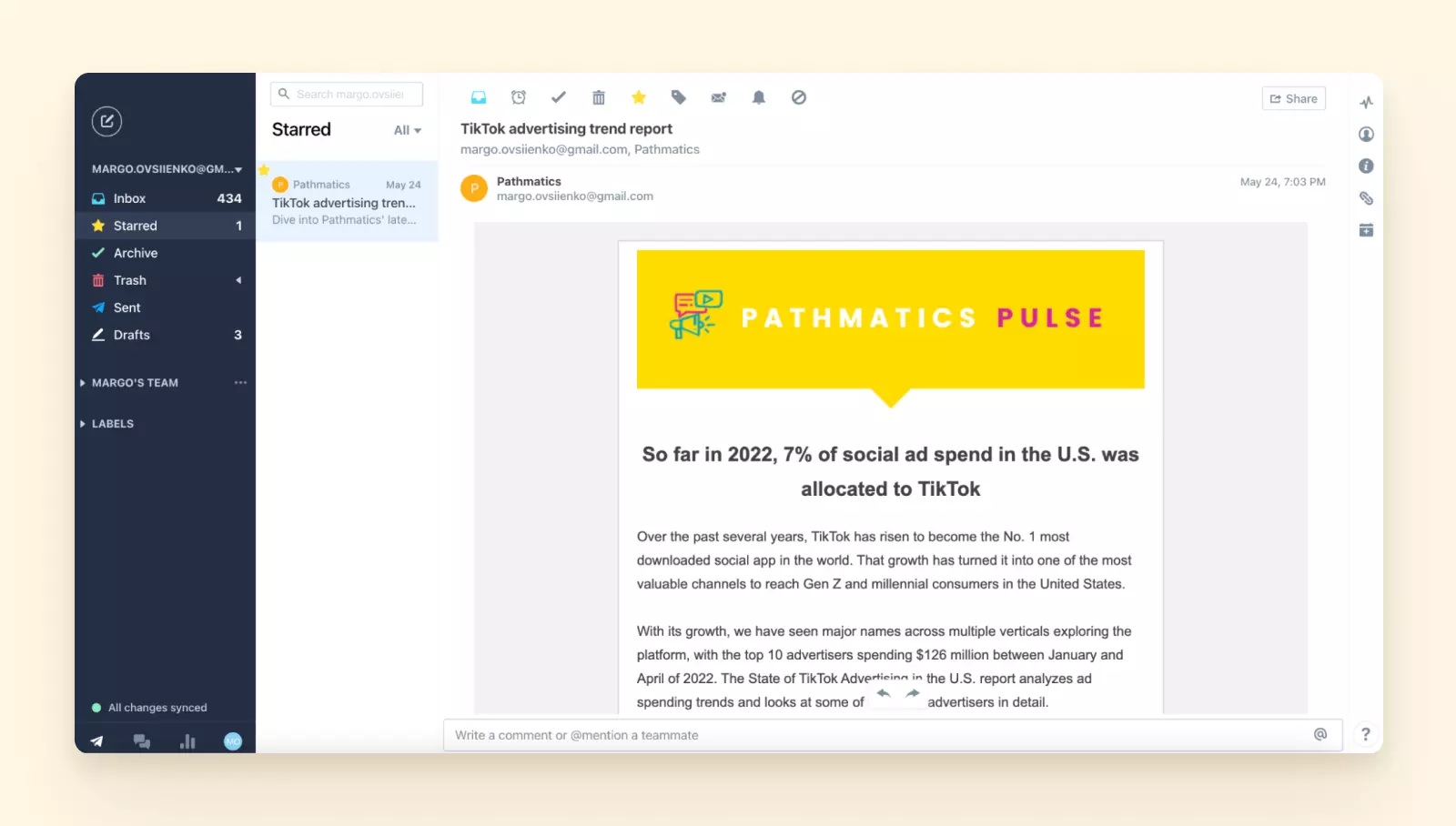
Polymail is an email management solution designed for sales teams and professionals who need advanced tracking capabilities. According to industry analysis, email tracking and productivity tools have become essential features for business communication, particularly in sales-focused environments. The app is available for Mac, iOS, and Windows users, but not Android.
- Key features
-
- Email reminders
-
You can set up follow-up reminders in Polymail for emails that haven't received responses. According to Microsoft's productivity research, automated follow-up systems can improve response rates by ensuring timely communication. Some email providers such as Gmail already offer this option by default, while in Outlook, you have to dig through the settings to find it.
- Email tracking
-
Wondering whether your client has even read your message? With email tracking, you can check if and when a recipient has opened your email. Industry research from Gartner indicates that email tracking capabilities have become standard features in sales-focused email clients, helping professionals optimize their outreach timing.
- Message templates
-
In Polymail, you can create multiple email templates and add placeholders populated with contact details whenever you create a new email. According to sales productivity studies, template systems can reduce email composition time significantly, making them particularly valuable for repetitive emails or sales pitches.
- Contact management
-
By clicking a contact in your inbox, you can see a preview of all previous emails and attachments. If you need to adjust a contact's details, you can perform basic editing. This unified contact view helps maintain context across email conversations.
- Undo send
-
Polymail allows you to unsend a message within seconds of clicking Send. During testing, the "unsend" option provides a brief window to recall messages, though the exact timing may vary based on server synchronization.
- Unified accounts
-
With this email client, you have an option to work with all your emails from one inbox. All you have to do is connect the accounts. According to email management best practices, unified inbox functionality improves productivity by eliminating the need to switch between multiple email interfaces. Microsoft Outlook doesn't offer this feature in its standard configuration.
- Integrations
-
Polymail integrates with various third-party apps, such as Slack, Salesforce, HubSpot, Zoom, and Asana. You can also find most of these integrations among Microsoft Outlook's add-ins. Industry analysis shows that CRM and collaboration tool integrations have become essential for sales-focused email clients.
- Security
-
Polymail states that no one is collecting information on your passwords and user data is stored as a one-way hash, making it impossible for hackers to fetch your password. The service uses AES encryption. According to NIST security guidelines, AES encryption represents industry-standard protection for email data at rest.
- Pricing
-
Polymail is a paid email client and doesn't offer a freemium plan. Paid accounts are available with monthly subscription options. The entry-level plan has limitations on the number of email accounts you can connect.
- User reviews
-
G2 – 4.5/5 (110+ reviews)
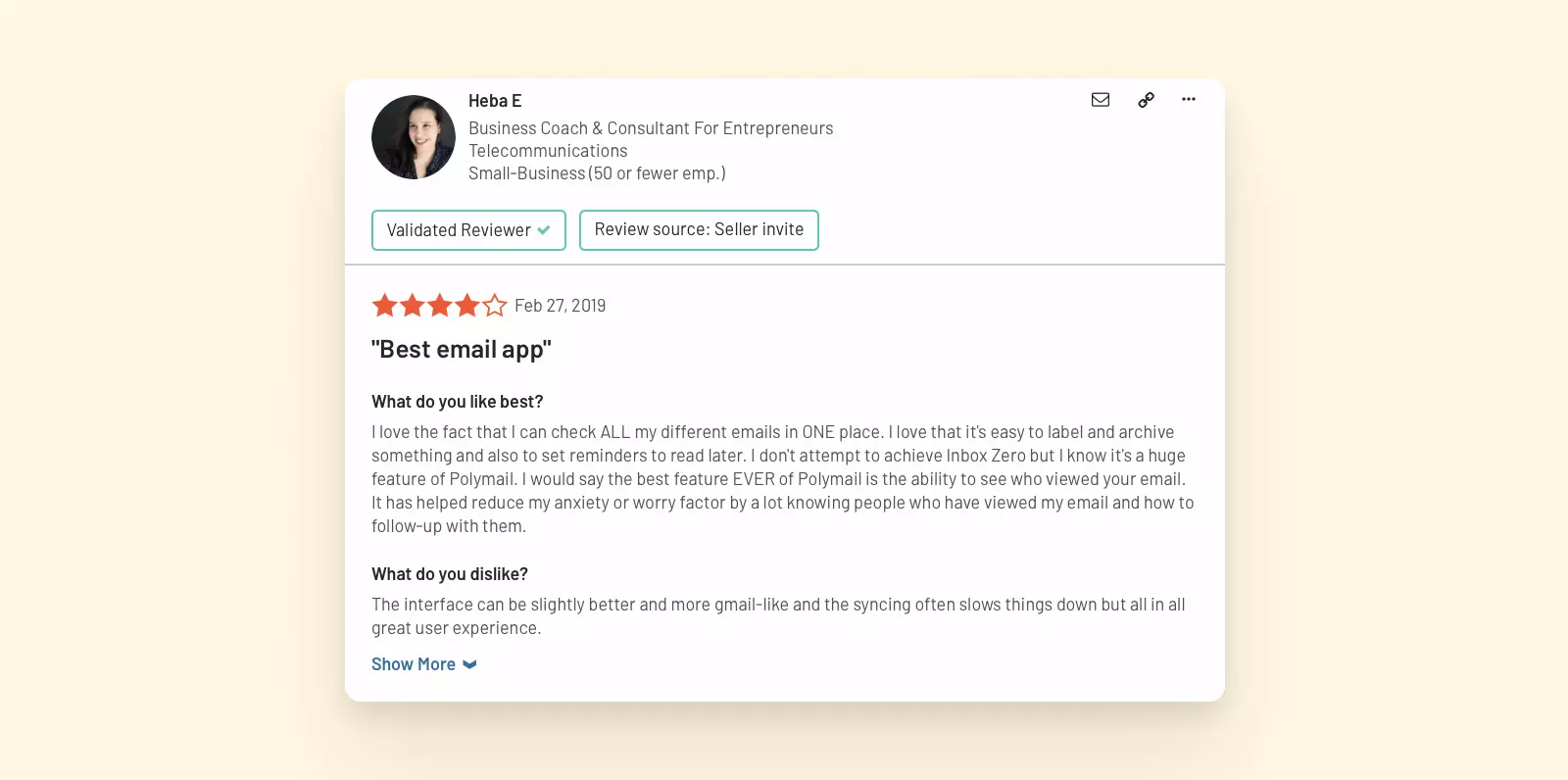
User review of Polymail from G2 platform highlighting its email tracking and productivity features - Major Pros
-
- Offers unified inbox for multiple accounts
- Useful built-in features such as email tracking
- Improves team collaboration
- A great tool for email outreach and sales
- Major Cons
-
- Limited integrations compared to enterprise solutions
- No Android app
- Sync challenges reported by some users
- Verdict
-
Polymail is a user-friendly and intuitive email client designed specifically for sales professionals and teams who need advanced tracking capabilities. According to user feedback analysis, all key features are easily accessible on its interface, eliminating the need to dig through complex settings menus like in Outlook.
However, some users report synchronization issues when managing multiple accounts. Testing results suggest that Polymail works best for sales-focused teams who prioritize email tracking and template functionality over broad platform compatibility. If you need Android support or require enterprise-grade synchronization reliability, consider alternatives with broader platform coverage.
Outlook vs. Polymail — Comparison
| Polymail | Outlook | |
|---|---|---|
| Unified accounts | 4/5 | 1/5 |
| Unified calendar | 4/5 | 1/5 |
| Customization options | 3/5 | 3/5 |
| Ease of onboarding | 5/5 | 3/5 |
| UX & UI | 4/5 | 3/5 |
| Security | 5/5 | 5/5 |
| Integrations | 4/5 | 4/5 |
| Performance | 3/5 | 4/5 |
| Pricing | $13/month per user | $6/month per user |
Shift
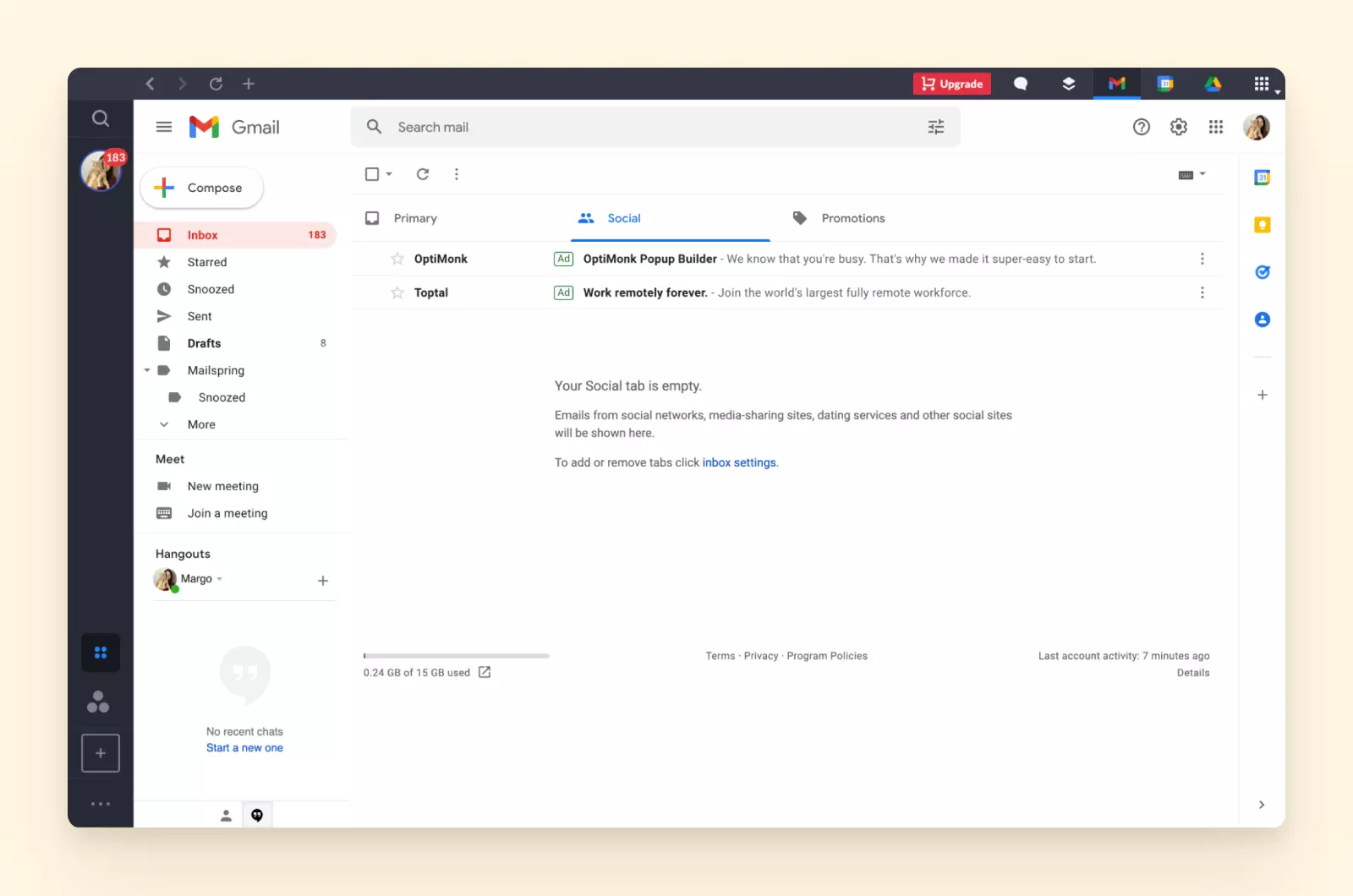
Shift is an email client that consolidates multiple email accounts and applications into a unified workspace. According to productivity software research from Forrester, workspace consolidation tools can reduce context-switching time by up to 40%, making solutions like Shift particularly valuable for users managing multiple accounts.
However, Shift's email provider support is limited to Gmail and Microsoft Outlook, with Yahoo and iCloud available only as app integrations. The platform currently offers desktop versions for Mac and Windows, but lacks mobile applications—a significant limitation according to Gartner's research indicating that 67% of professionals require mobile email access for productivity.
- Key features
-
- Multiple accounts management
-
You can add email accounts for Gmail and Microsoft Outlook. However, the platform doesn't support POP or IMAP protocol integration, which limits compatibility with less mainstream email providers.
- Unified search
-
The unified search functionality allows you to search across all connected accounts simultaneously, locating message threads, calendar events, and attachments through a single search interface.
- Internet search bar
-
An integrated Internet search bar enables web browsing directly within the application interface, eliminating the need to switch to external browsers like Chrome or Safari.
- Workspace
-
Shift enables you to create separate workspaces and share them with team members. Each workspace can be customized with specific tools, tabs, and bookmarks tailored to different projects or workflows.
- Integrations
-
Shift provides integration capabilities with hundreds of third-party productivity tools including Asana, Evernote, and Slack. According to Statista's workplace productivity research, centralized app management can improve workflow efficiency by reducing the time spent navigating between different platforms.
- Security
-
Shift implements the OAuth authorization protocol for secure account authentication. However, the platform currently lacks compliance certifications for HIPAA, SOC2, and ISO 27001—standards that NIST recommends for enterprise-grade security implementations.
- Pricing
-
Shift offers a free version with support for up to two email accounts, providing basic functionality for users with minimal account management needs.
Paid subscription plans are available starting at approximately $99 per year for single-user access, positioning Shift in the premium tier of email client pricing.
- User reviews
-
G2 – 3.8/5 (55 reviews – May 2022)
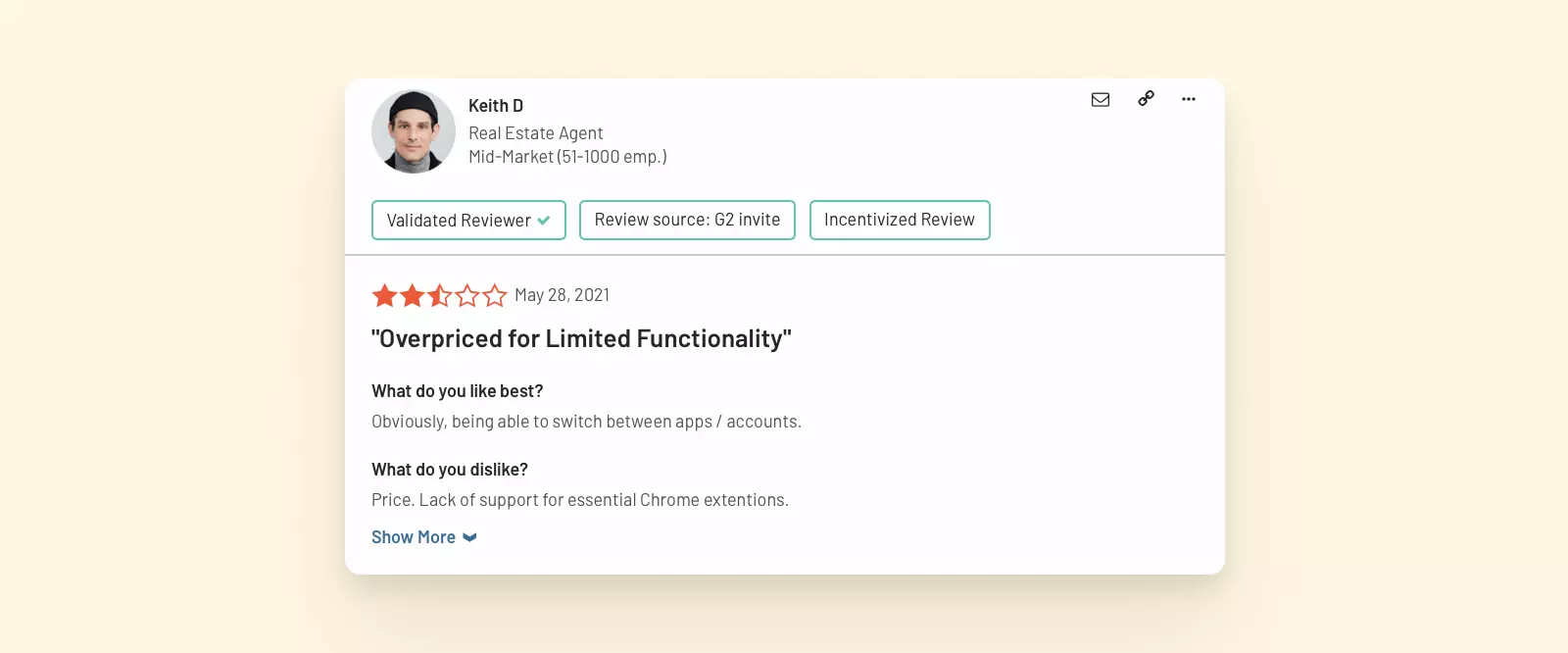
Negative review of Shift email client with a 3.8/5 rating on G2 as of May 2022 - Pros
-
- Rich collaboration features for team-based workflows
- Unified workspace consolidating multiple accounts
- Cross-account search functionality
- Extensive productivity app integrations
- Cons
-
- Premium pricing structure compared to alternatives
- Performance inconsistencies and reported system bugs
- Limited email provider support (no POP/IMAP)
- No mobile application availability
- Verdict
-
Shift presents a compelling solution for users seeking to consolidate multiple accounts and productivity applications into a single workspace. The platform's extensive integration ecosystem and unified search capabilities address common productivity challenges associated with managing multiple email accounts.
However, testing reveals significant limitations that may impact user experience. The restriction to Gmail and Microsoft Outlook accounts—without POP or IMAP protocol support—severely limits compatibility with alternative email providers. User feedback consistently highlights performance inconsistencies and system stability issues, which can disrupt workflow efficiency. Additionally, the premium pricing structure positions Shift among the more expensive email client solutions, while the absence of mobile applications limits accessibility for users requiring on-the-go email management.
Outlook vs. Shift — Comparison
| Shift | Outlook | |
|---|---|---|
| Unified accounts | 4/5 | 1/5 |
| Unified calendar | 4/5 | 1/5 |
| Customization options | 4/5 | 3/5 |
| Ease of onboarding | 5/5 | 3/5 |
| UX & UI | 4/5 | 3/5 |
| Security | 5/5 | 5/5 |
| Integrations | 4/5 | 4/5 |
| Performance | 3/5 | 4/5 |
| Pricing | $99/year per user | $6/month per user |
Front
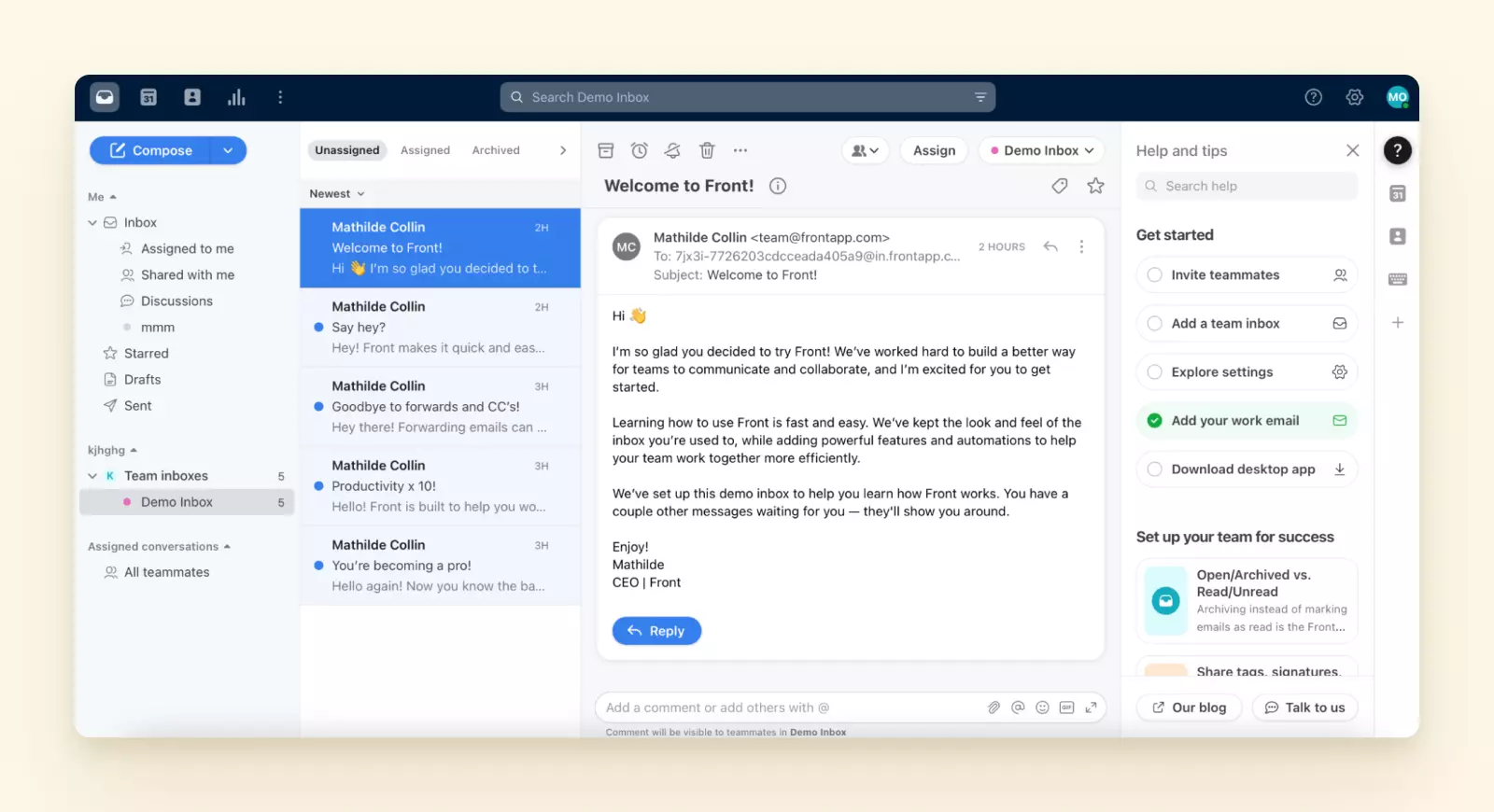
Front is an email app and customer communication platform that helps teams turn conversations into tickets. With Front, you can connect multiple email accounts and manage them from one place with ease.
This email tool offers some interesting features that enhance team collaboration, such as email assignments. The app is available for Windows, Mac, iOS, and Android users.
- Key features
-
- One-click meeting scheduling
-
With Front, you can add calendars belonging to different email providers and create, manage, and preview online events. Creating an event in Front is easy. However, the functionalities of the calendar view don't go beyond what most email clients offer.
- Consolidated workspace
-
You can connect multiple email accounts and manage them from one dashboard. Apart from viewing all your messages from one inbox, you can also access emails assigned to you from a separate folder.
- Message templates
-
You can create message templates right from the "new email" view, while most email clients that offer this feature only allow you to do so through the settings. The template editor lets you add dynamic fields with placeholders, such as names, surnames, or company names — a useful feature for those who don't want to dig through contact's personal details every time they use an email template.
- Snoozing messages
-
You can snooze certain emails by adjusting your snooze preferences — choose between the presets or set up your own time. In the settings, you can also modify custom snooze options to apply as defaults. Note: you can apply the snooze option in bulk when you want to snooze multiple emails or senders.
- Contact management
-
Similar to most other email clients, in Front, you can preview your communication history with a certain client, including previous messages and notes. You can also easily edit a contact's profile with social media account links or descriptions. However, you can't easily locate attachments when viewing contacts.
- Integrations
-
Front integrates with a lot of third-party tools you might be using, such as Zapier, Aircall, Salesforce, Slack, Shopify, and Dropbox. However, unlike with Outlook where you get all the add-ins and integrations with every subscription, Front limits access to certain integrations, making them available only in more expensive plans.
- Security
-
According to Front's official security documentation, all information handled on a user's Front account is protected with TLS 1.2 encryption and AES 256-bit encryption. Front is compliant with GDPR and CCPA. Multi-factor authentication is applied to all accounts. You can also restrict access to data for certain accounts based on their IP addresses, but note that this is available only for more expensive subscriptions.
- Pricing
-
Front offers tiered pricing plans with only annual billing available. There are also requirements for a minimum number of users in certain subscriptions. For example, to start using the Prime package, you need to pay for a minimum of five users.
- User reviews
-
G2 – 4.7/5 (1,900+ reviews – 2025)
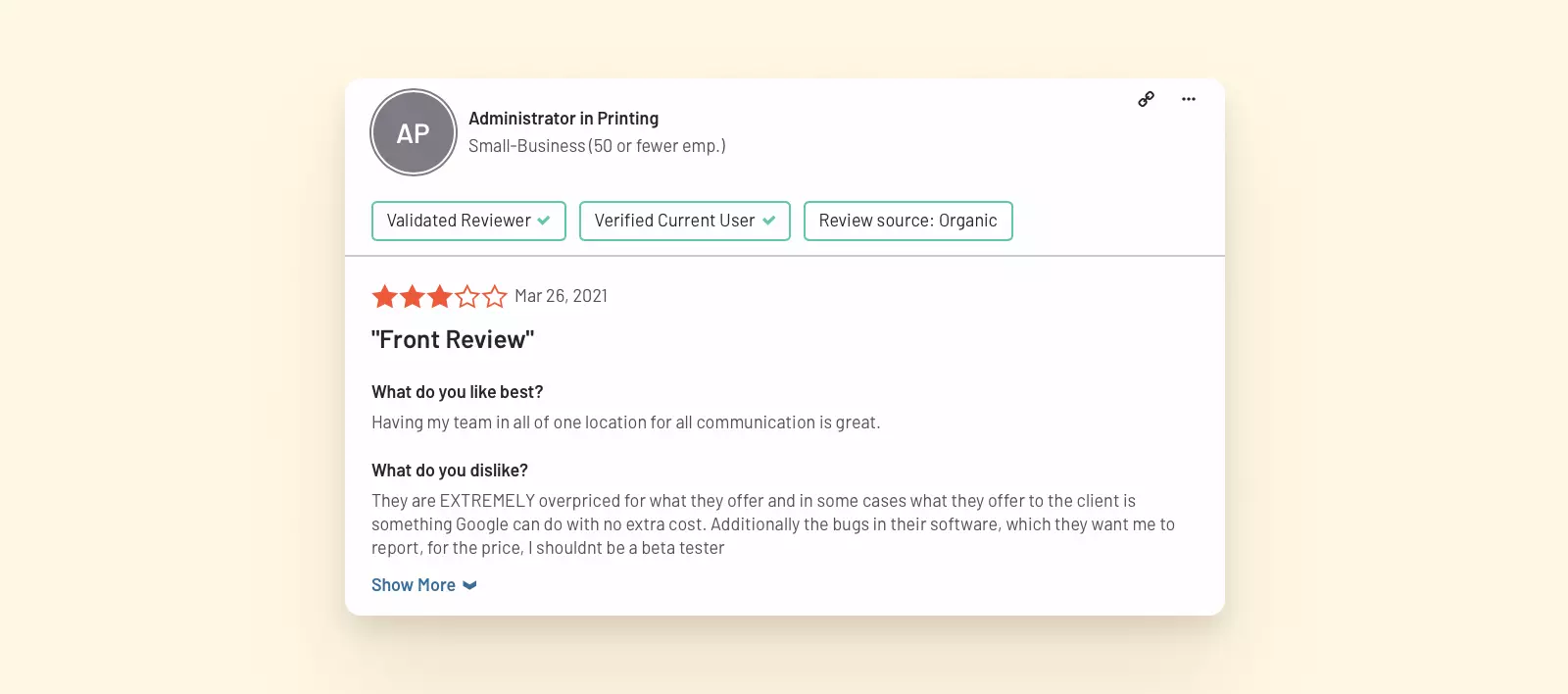
Front email app with a high user rating of 4.7/5 from over 1,900 reviews in 2025 - Pros
-
- Manage all company emails from one place
- Intuitive designs
- A lot of useful integrations
- Cons
-
- Interfaces look a bit cluttered
- Support is not always responsive
- No free version
- Verdict
-
Front can be a good Outlook alternative for bigger teams that manage customer relationships. If you are an individual user or have just a couple of employees, Front might be the wrong choice for you.
When in need of certain high-tier features, you should pay for additional accounts even if you are not using them because of the minimum user count requirements for paid plans. For many users, Front can be expensive, especially if you have a high-growth team.
Front does offer some useful features and lets you connect various email providers (which Outlook doesn't do), but other email clients also offer this feature at a considerably lower price. Research from Gartner's customer service software analysis indicates that organizations should carefully evaluate per-user pricing models against their actual team size and growth projections before committing to platforms with minimum user requirements.
Outlook vs. Front — Comparison
| Front | Outlook | |
|---|---|---|
| Unified accounts | 4/5 | 1/5 |
| Unified calendar | 4/5 | 1/5 |
| Customization options | 4/5 | 3/5 |
| Ease of onboarding | 5/5 | 3/5 |
| UX & UI | 3/5 | 3/5 |
| Security | 5/5 | 5/5 |
| Integrations | 5/5 | 4/5 |
| Performance | 4/5 | 4/5 |
| Pricing | $19/month per user | $6/month per user |
Overview of Microsoft Outlook
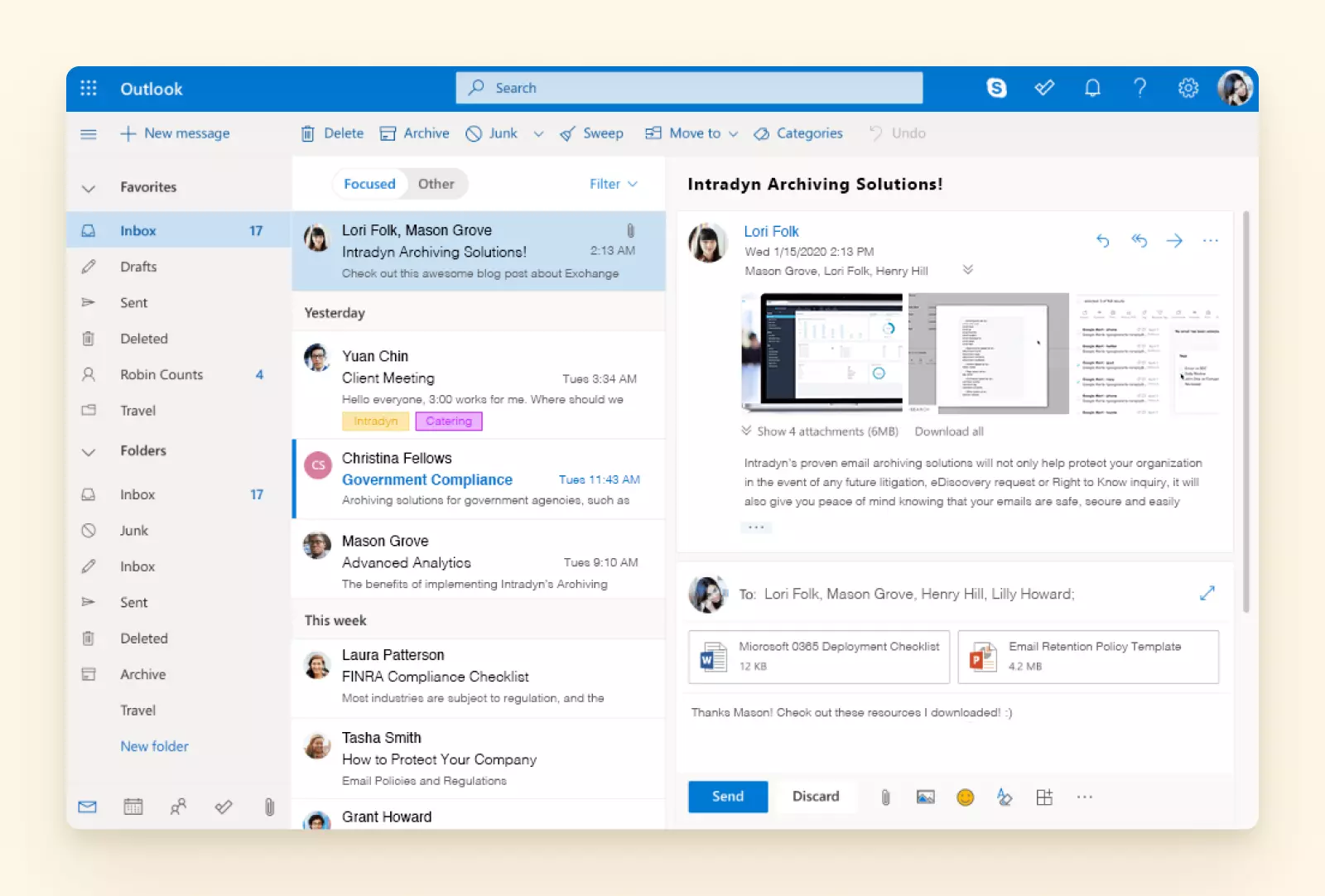
Microsoft Outlook is an email client that has already hit 200 million users, making it one of the top email choices for both companies and individuals. As part of Microsoft's Office suite, it has been a workplace standard for decades.
It’s been 25 years since Microsoft Outlook’s inception. Outlook was one of the first email clients, and Microsoft has had plenty of time to maximize its potential.But now, it has only 8% of the market dominated by Apple and Gmail.
This means that the once-popular Outlook is slowly losing its position. Let’s see why.
Why Would You Search for an Outlook Alternative?
Since 1997, people have been juggling multiple email accounts for both professional and personal use. Some create separate mailboxes for newsletters, transactional receipts, or high-priority emails. It's become a necessity rather than a choice.
We're also drowning in more emails than ever before, thanks to the explosion of email marketing and sales outreach. According to Radicati Group's 2024 Email Statistics Report, the average business user now receives over 120 emails per day, yet our tools for managing this volume haven't kept pace with the growth.
Here's the real problem: as people started using more email accounts, managing them became increasingly frustrating. You're constantly switching between tabs, getting distracted, and feeling annoyed by inefficient email management. The need to manage all emails, calendars, tasks, and apps from one unified place has become critical, yet Outlook hasn't seriously addressed this fundamental issue. Research from McKinsey shows that knowledge workers spend 28% of their time managing email, making efficient email management crucial for productivity.
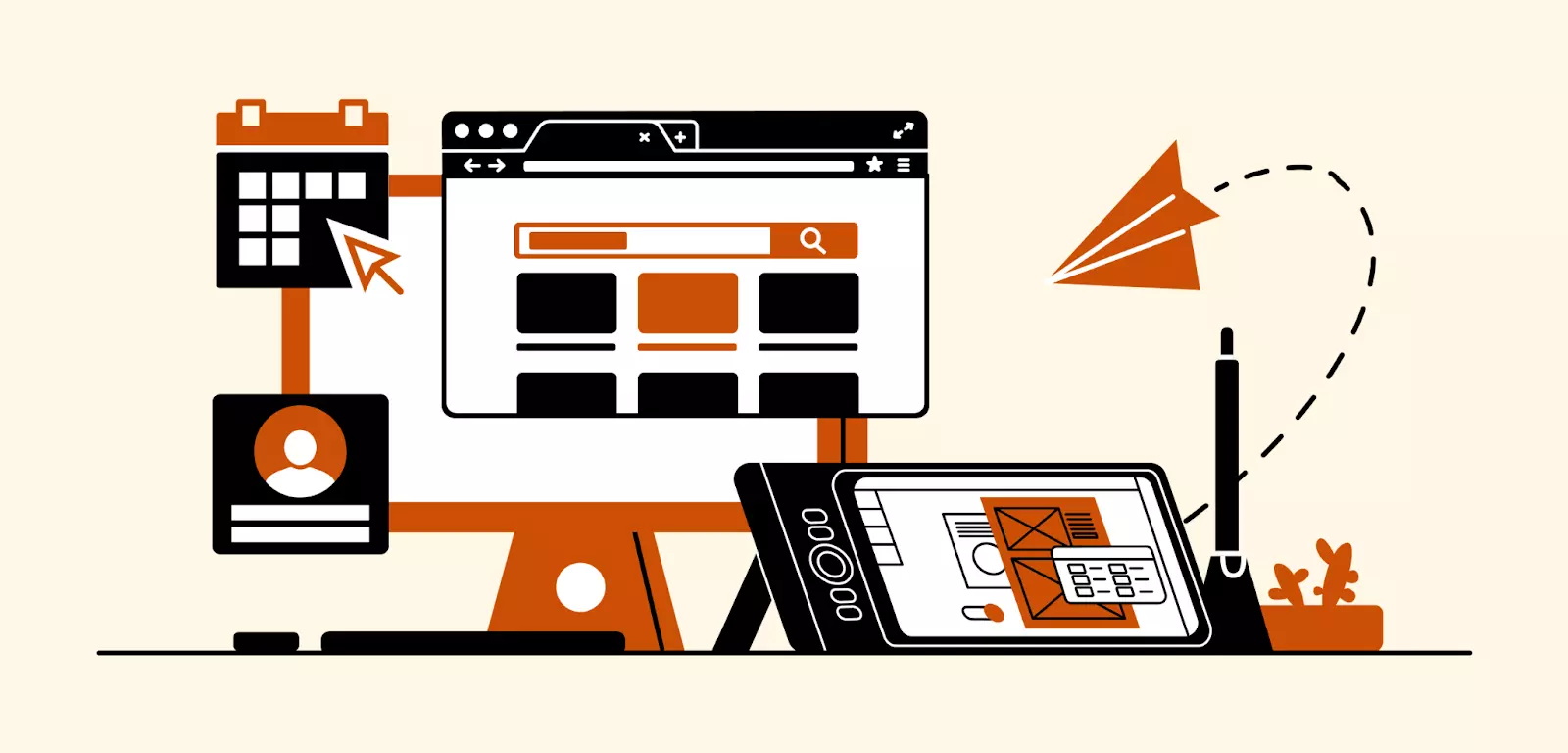
In Outlook, you can't access a unified inbox and calendar from a single view. You're still stuck switching through multiple tabs, and you can't really add any email provider other than Outlook to your account seamlessly. According to Microsoft's official Outlook documentation, while third-party email integration is possible, it lacks the streamlined unified inbox functionality that modern email clients offer.
Then there's the interface issue: Outlook looks and feels outdated. Many more user-friendly and intuitive email clients exist today, while Microsoft Outlook is often described as clunky and messy. The contrast is stark when you try modern alternatives that prioritize clean design and efficient workflows.
Don't get me wrong, Outlook is feature-rich after two decades of development. But accessing those features has become cumbersome and overwhelming. Microsoft clearly hasn't produced the best email client available, so if you have the flexibility to switch to something better, it's probably worth exploring your options. Gartner's workplace productivity research indicates that organizations are increasingly adopting specialized email clients to address specific workflow needs that traditional solutions like Outlook don't adequately serve.
What’s the Best Alternative to Outlook?
Microsoft has been building its core email product, Outlook, for over two decades. It has managed to introduce a lot of productivity features, but as the product grew, users started to feel overwhelmed with too many features, its clunky interface, and persistent bugs.
If you are looking for an Outlook alternative, your top choice should cover Outlook’s product and performance gaps and offer features similar to Outlook.
To make the task of shortlisting the winner easier for you, we have done all the heavy lifting of evaluating core features, security, pricing, and online reviews of key alternatives to Outlook.
By evaluating this short version of our comparisons and findings, you can quickly realize that Mailbird seems to tick all the boxes. To test Mailbird, sign up for a free trial.
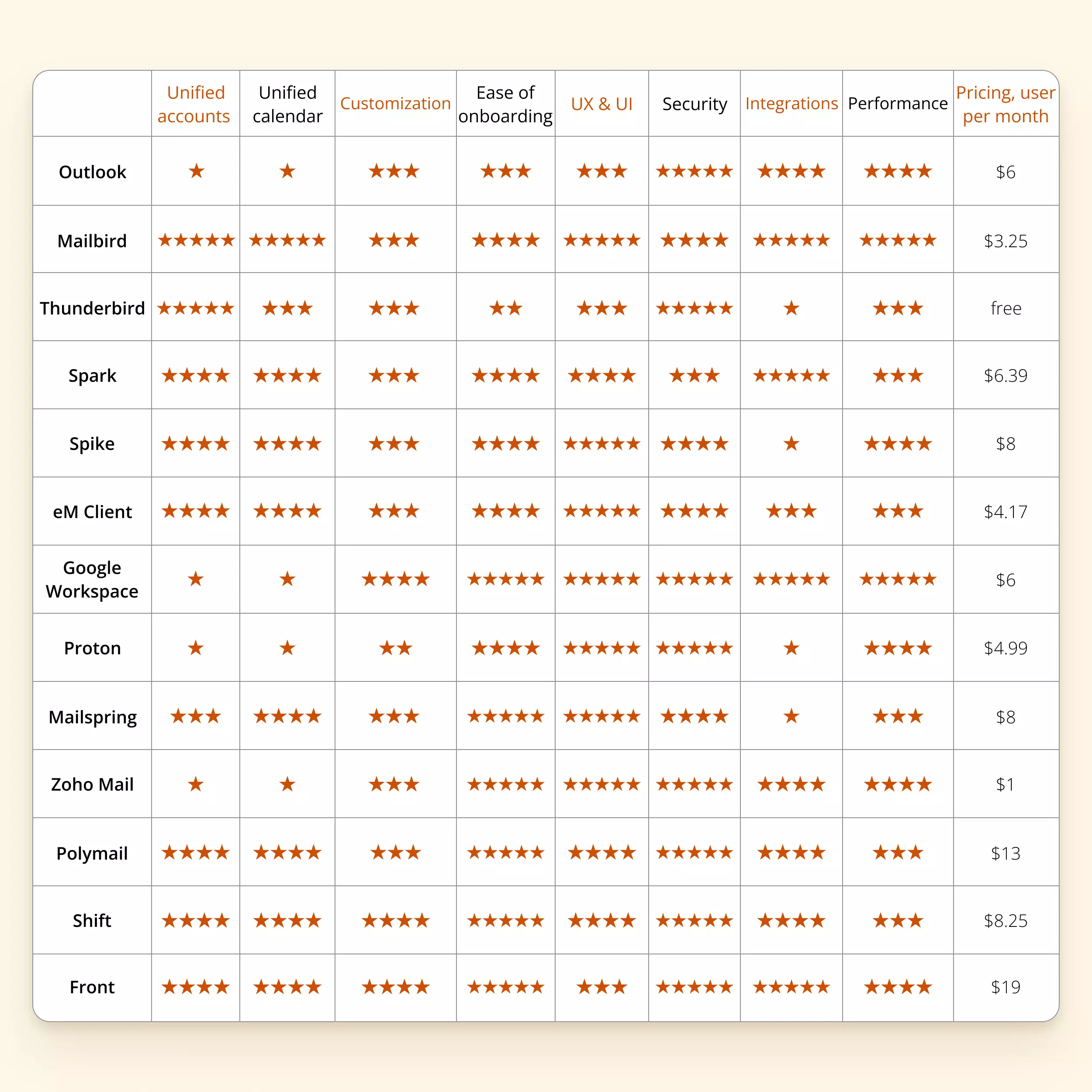
Frequently Asked Questions about Microsoft Outlook
What can replace Outlook?
A lot of email clients can be good alternatives to Outlook. For example, with Mailbird, you can connect multiple email accounts belonging to different providers and manage all your emails, calendars, and apps from one unified dashboard.
Are there any free alternatives to Outlook?
There are a few free alternatives to Outlook, such as Thunderbird, an open-source email client. However, with most free email alternatives to Outlook, you can experience bugs and lags in performance.
That’s why it’s worth considering paid email providers that let you add unlimited accounts, prioritize uptime, and access a full suite of productivity features.
What is an alternative to Outlook for Android?
You will soon be able to use Mailbird’s Android app.
What are specific alternatives to Outlook for Windows?
You can use Mailbird for all versions of Windows, up to 11, as an alternative to outlook. You can easily connect unlimited accounts from different email providers, access a native in-built calendar app for a unified calendar view, and integrate dozens of third-party productivity apps.
You can manage all your work from one unified dashboard to avoid online distractions and boost your productivity.
About This Review
This comprehensive comparison was conducted by Michael Bodekear and his team, who have been developing email productivity solutions since 2013. Our evaluation methodology includes hands-on testing of each email client, analysis of user reviews from verified platforms like G2 and the App Store, and assessment of security protocols based on industry standards. According to NIST's cybersecurity framework, regular evaluation of email client security features is essential for maintaining data protection standards. We regularly update our comparisons to reflect the latest features and market changes, ensuring you have access to current and accurate information for making informed decisions about your email management needs. Our testing process follows established software evaluation criteria as outlined by industry research organizations like Gartner, focusing on usability, security, integration capabilities, and overall performance metrics.
